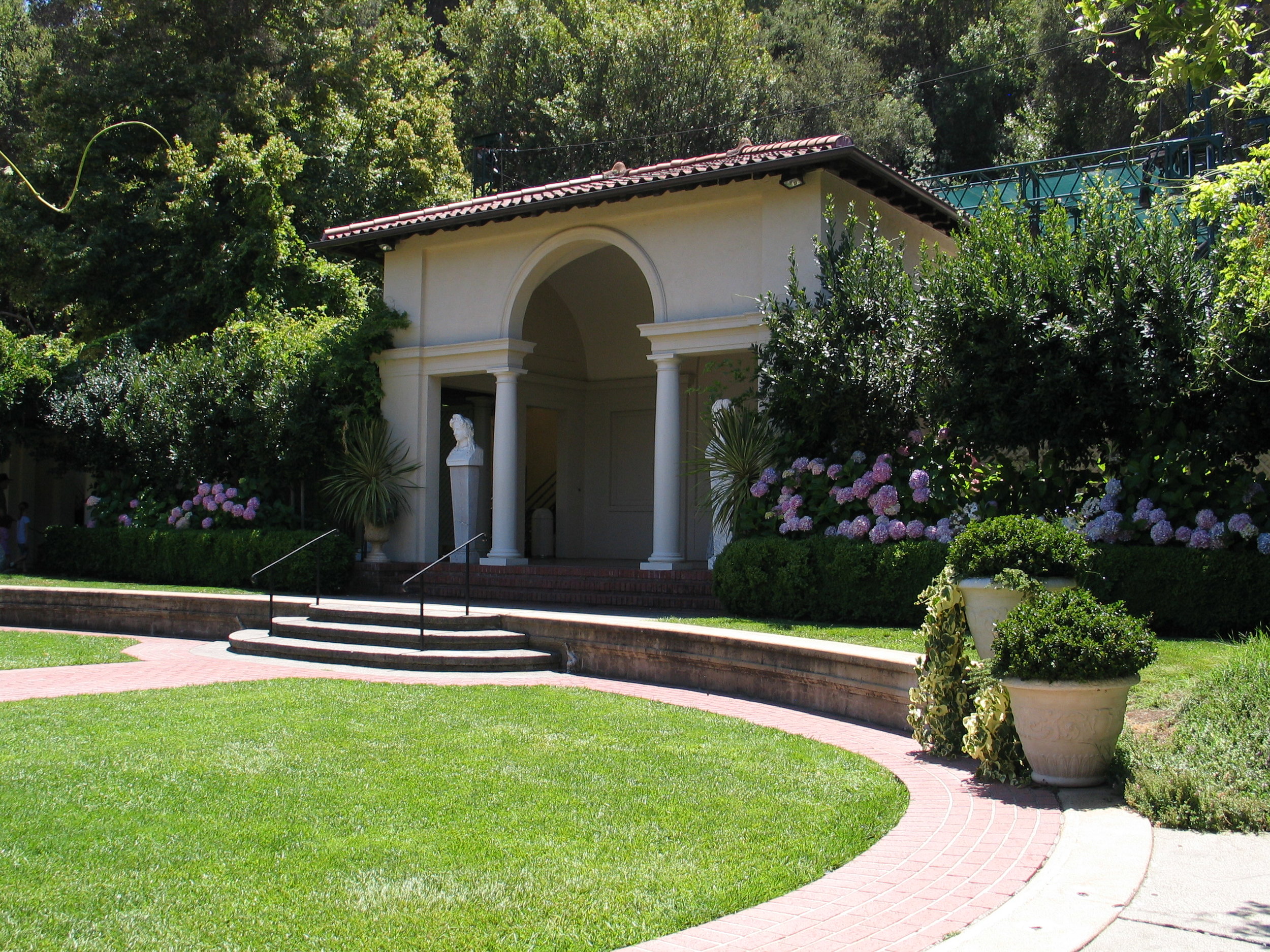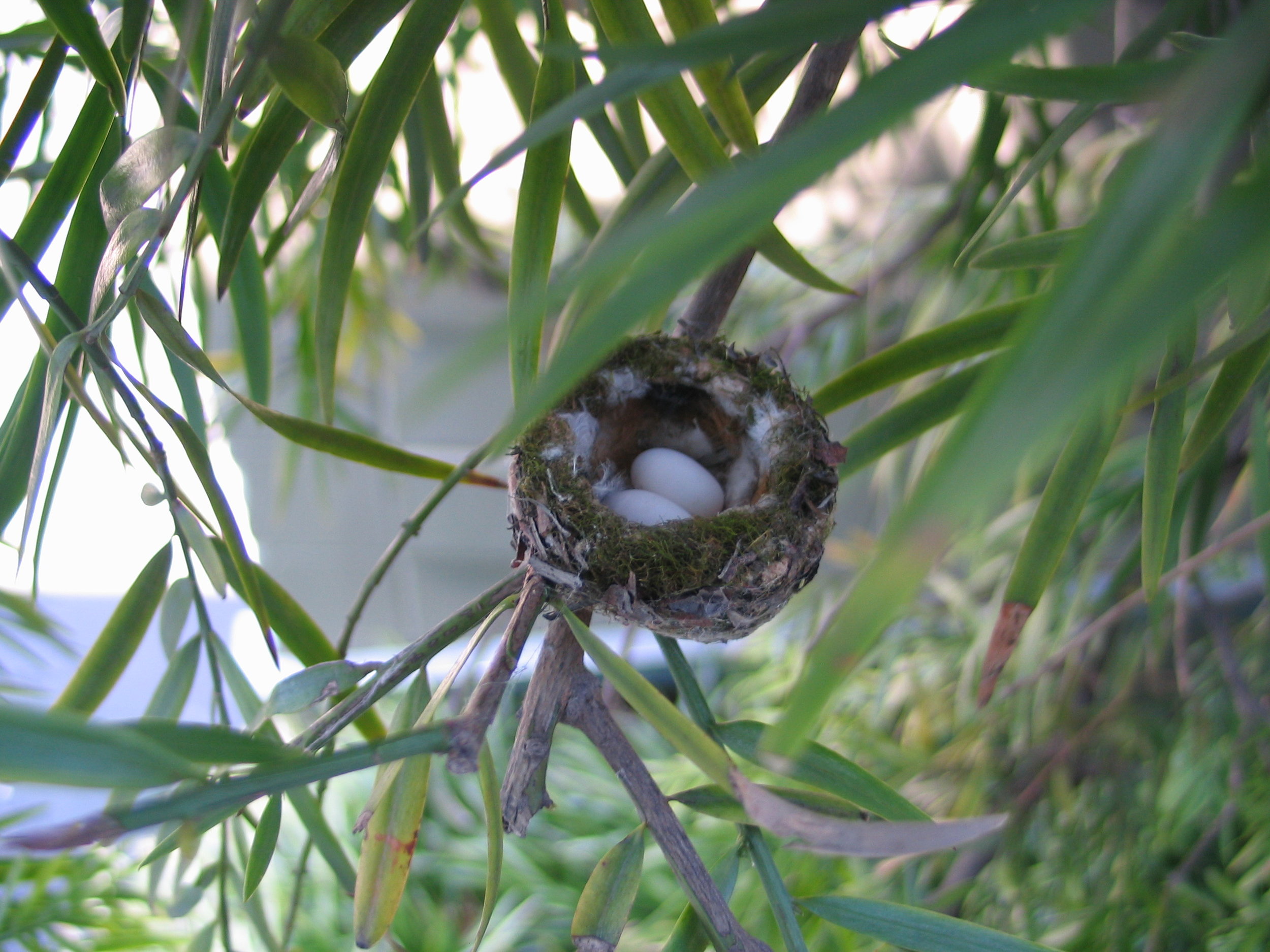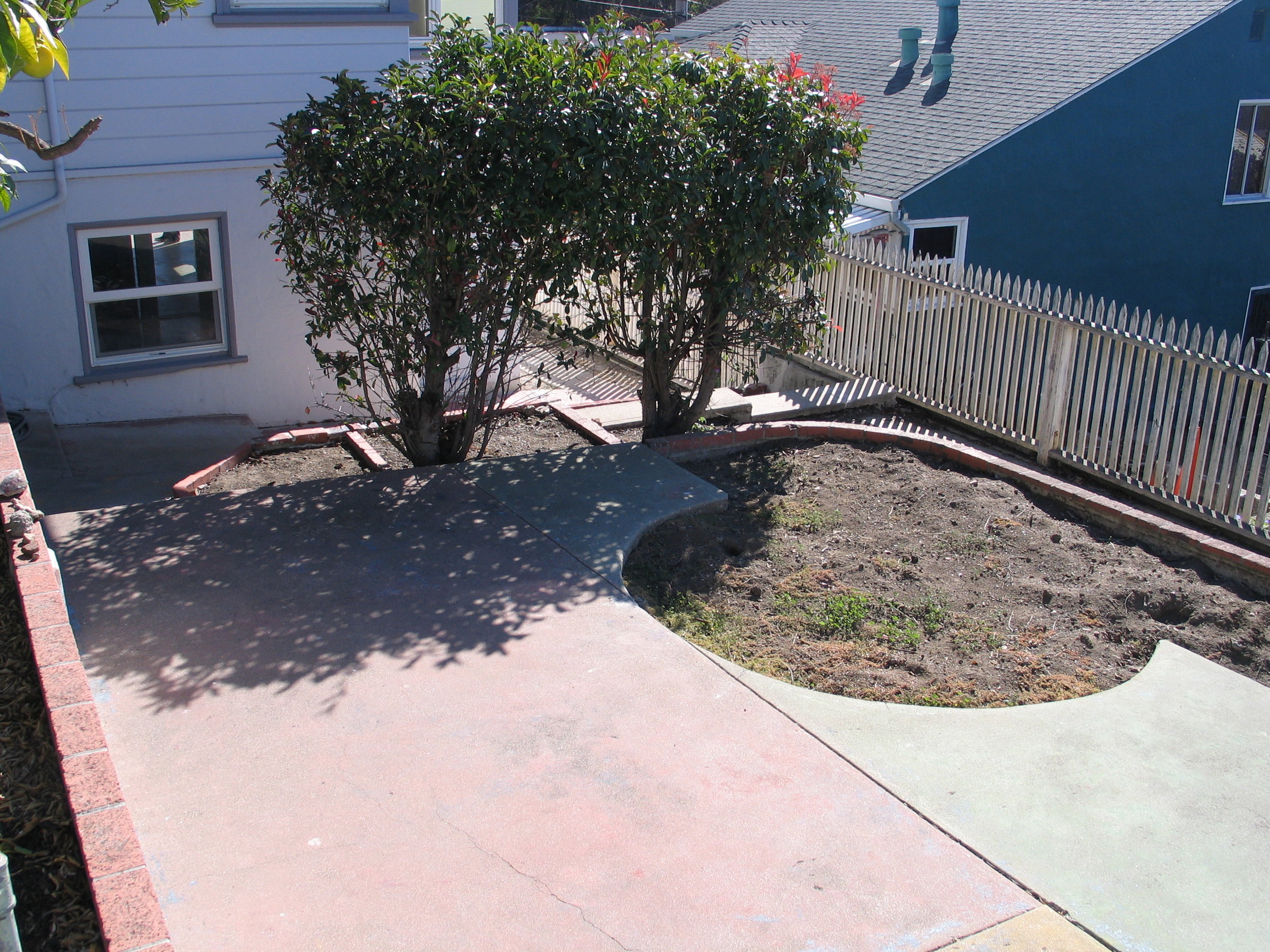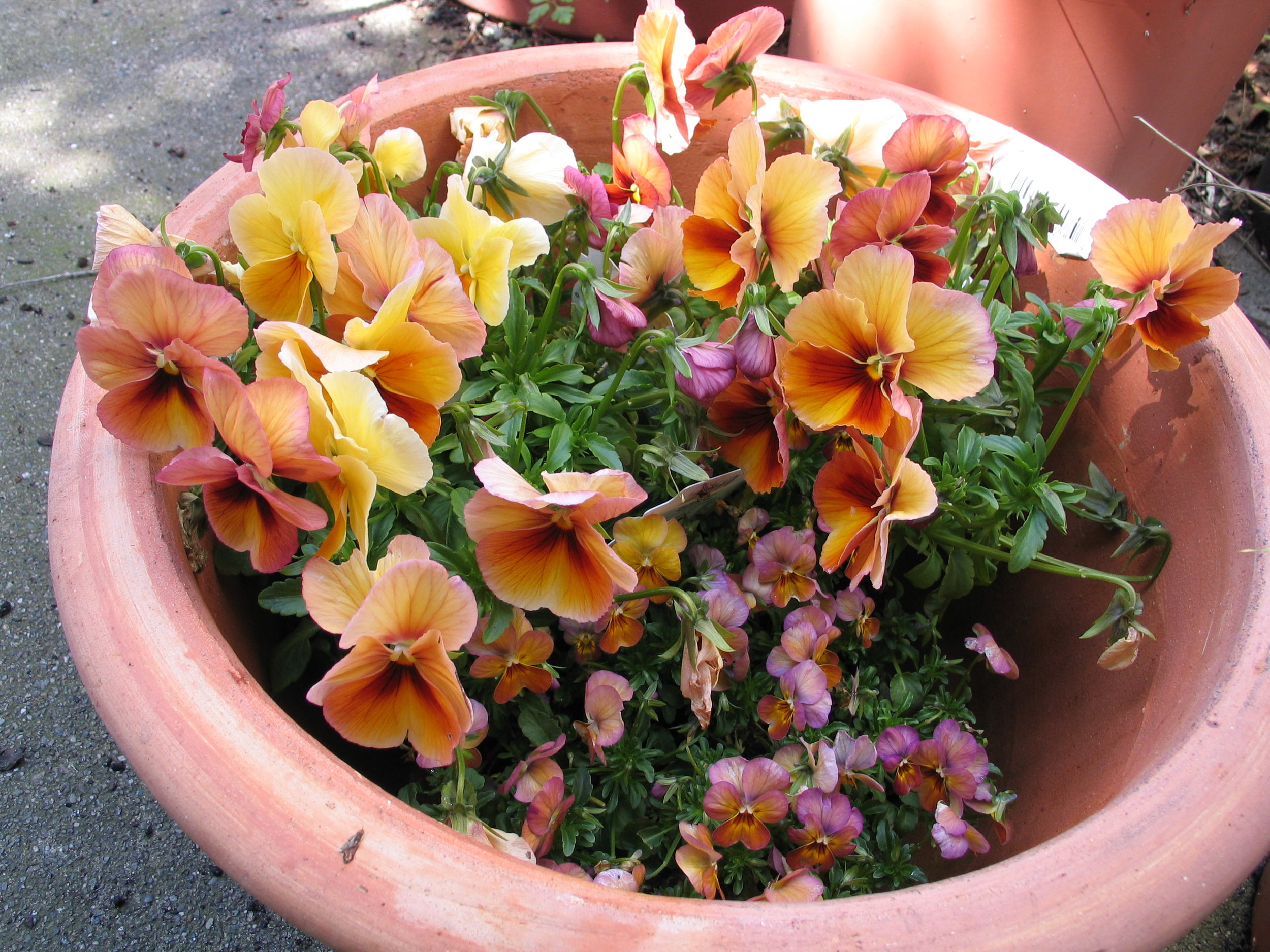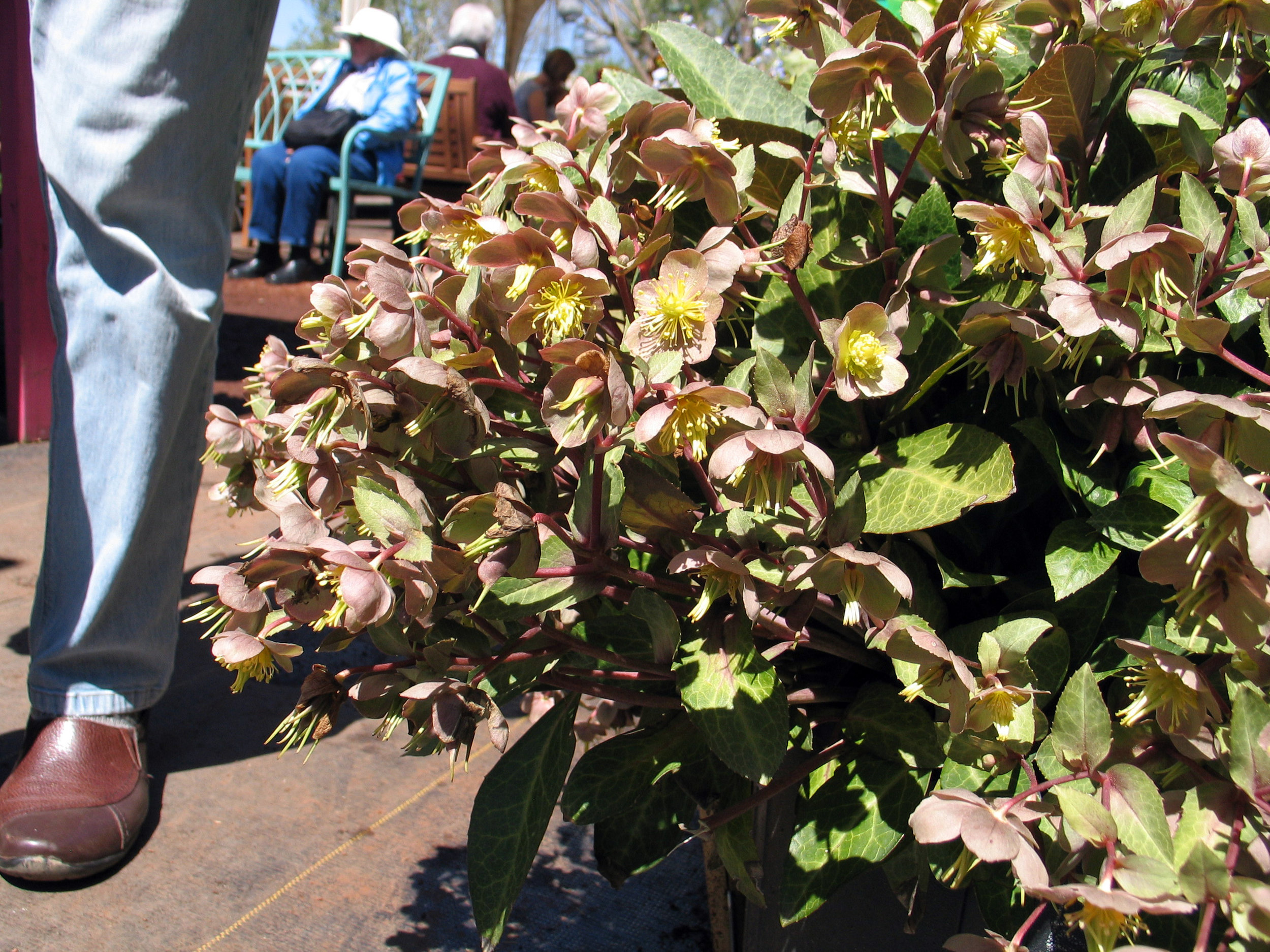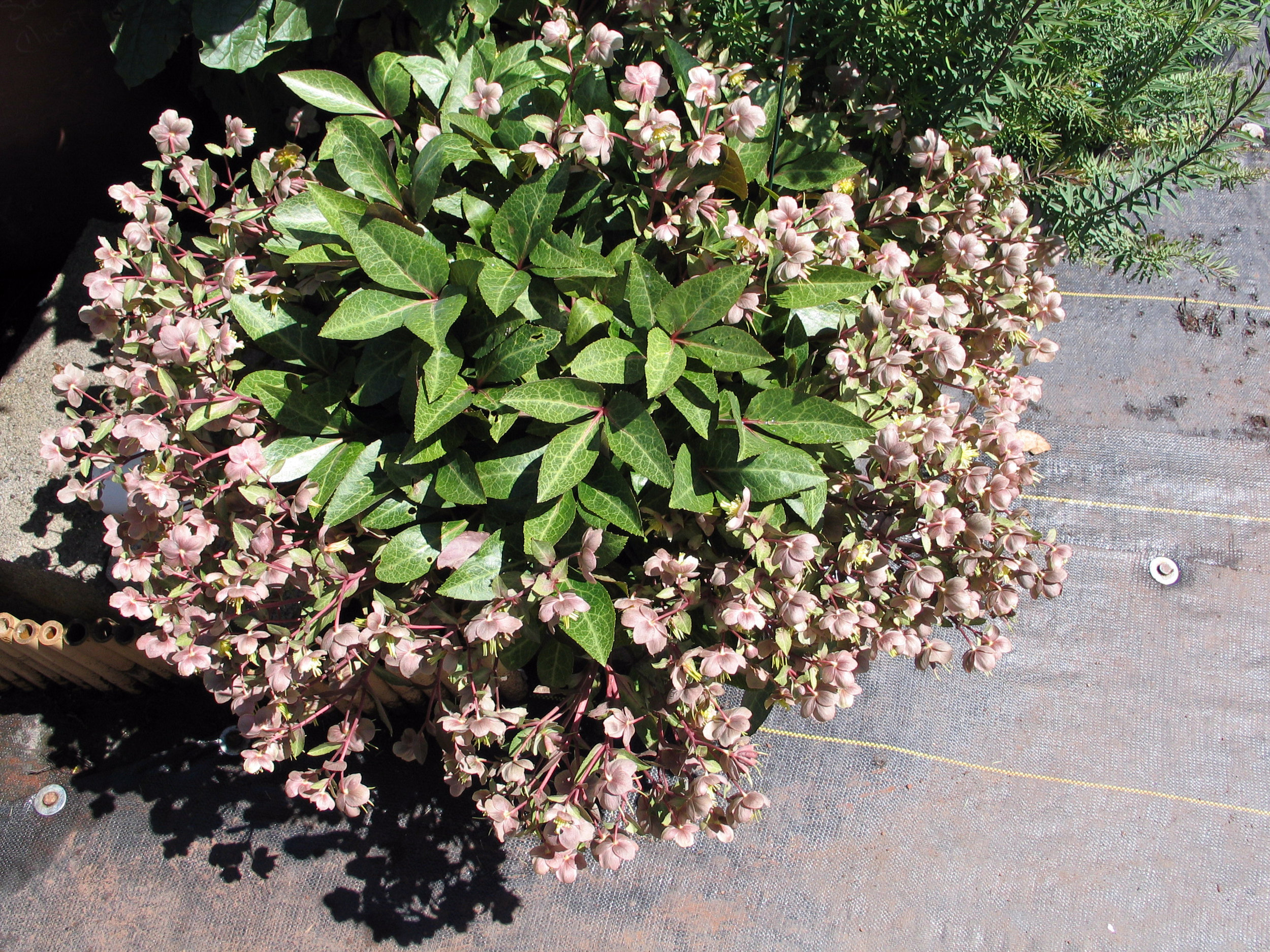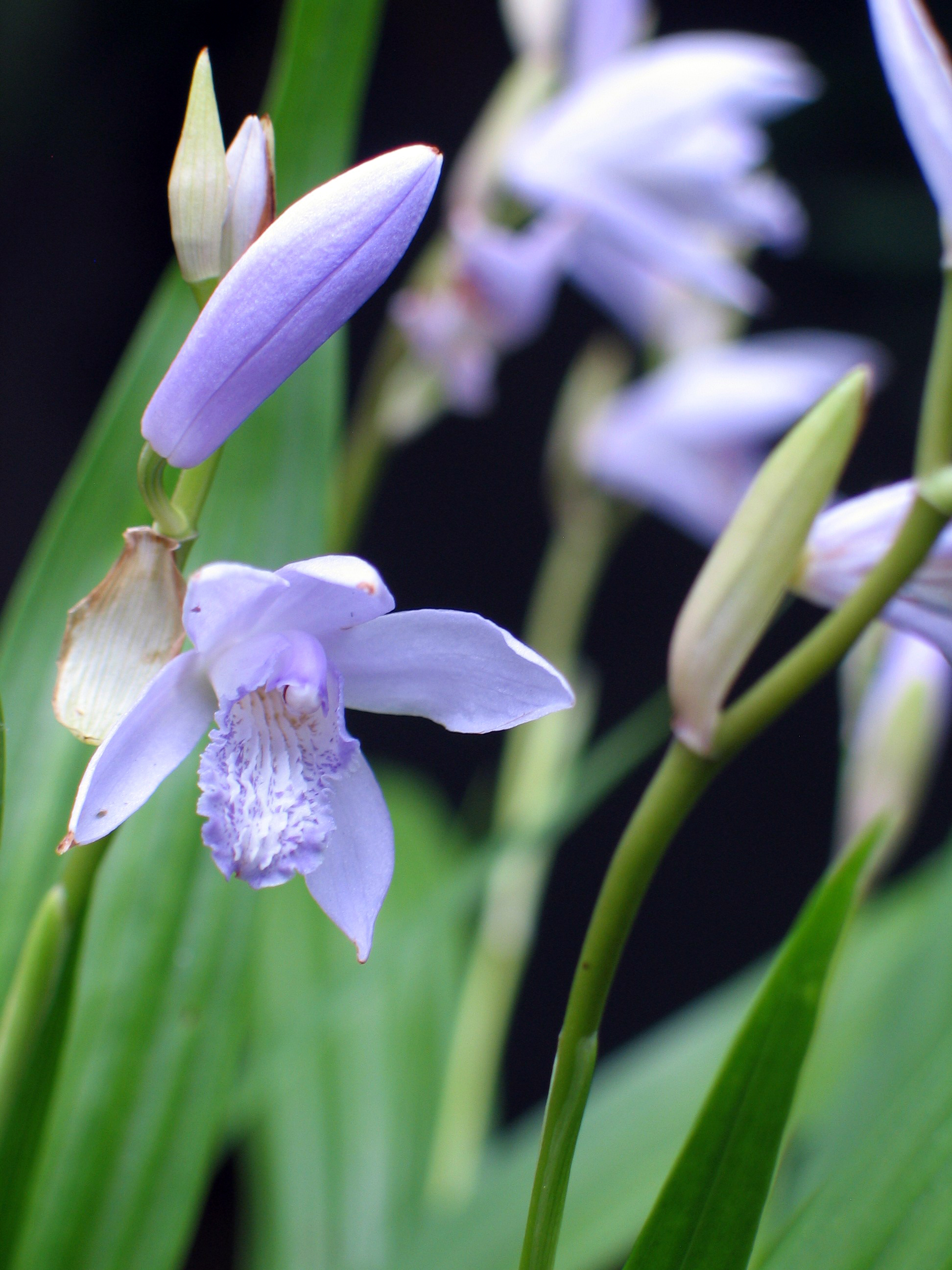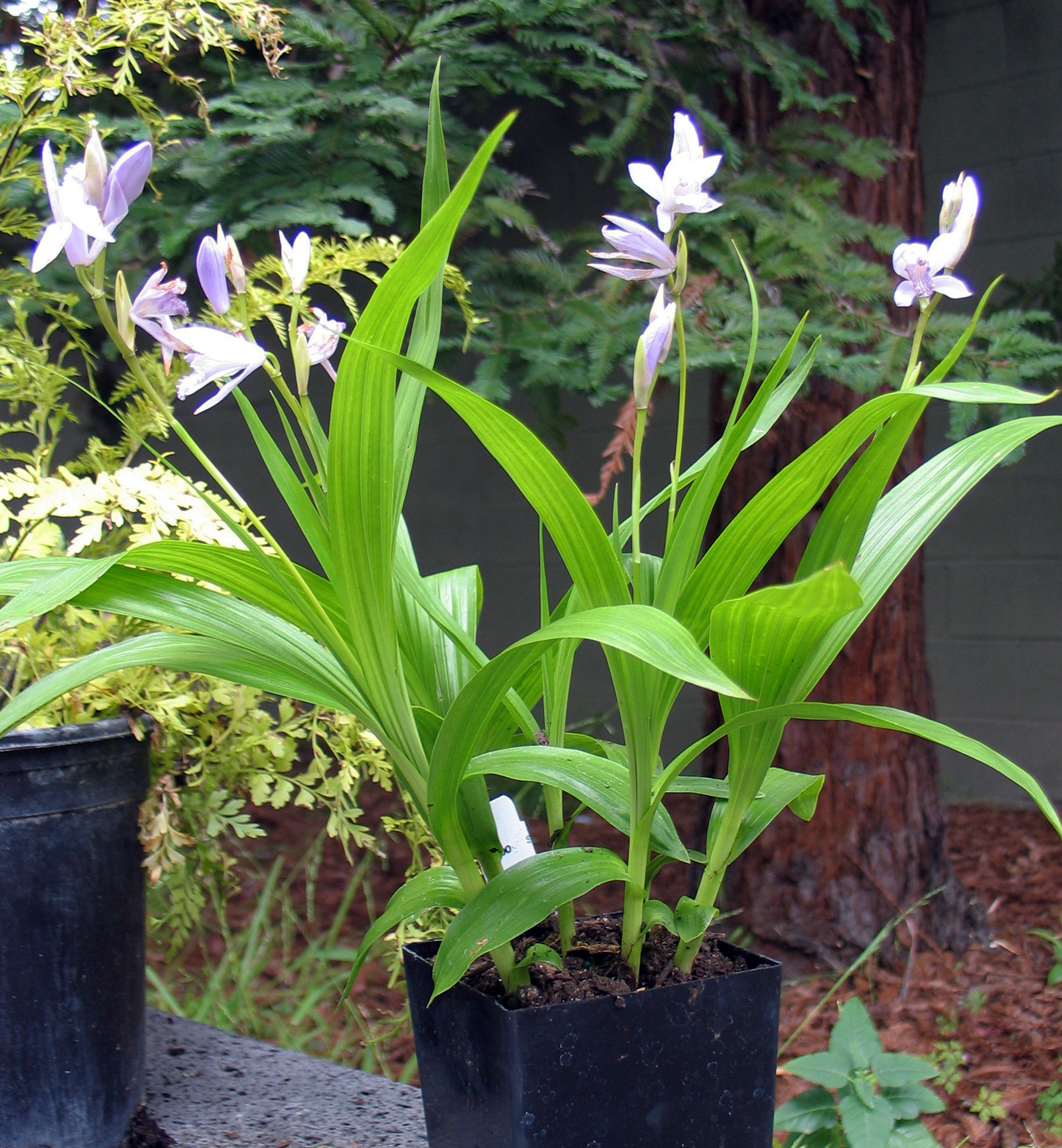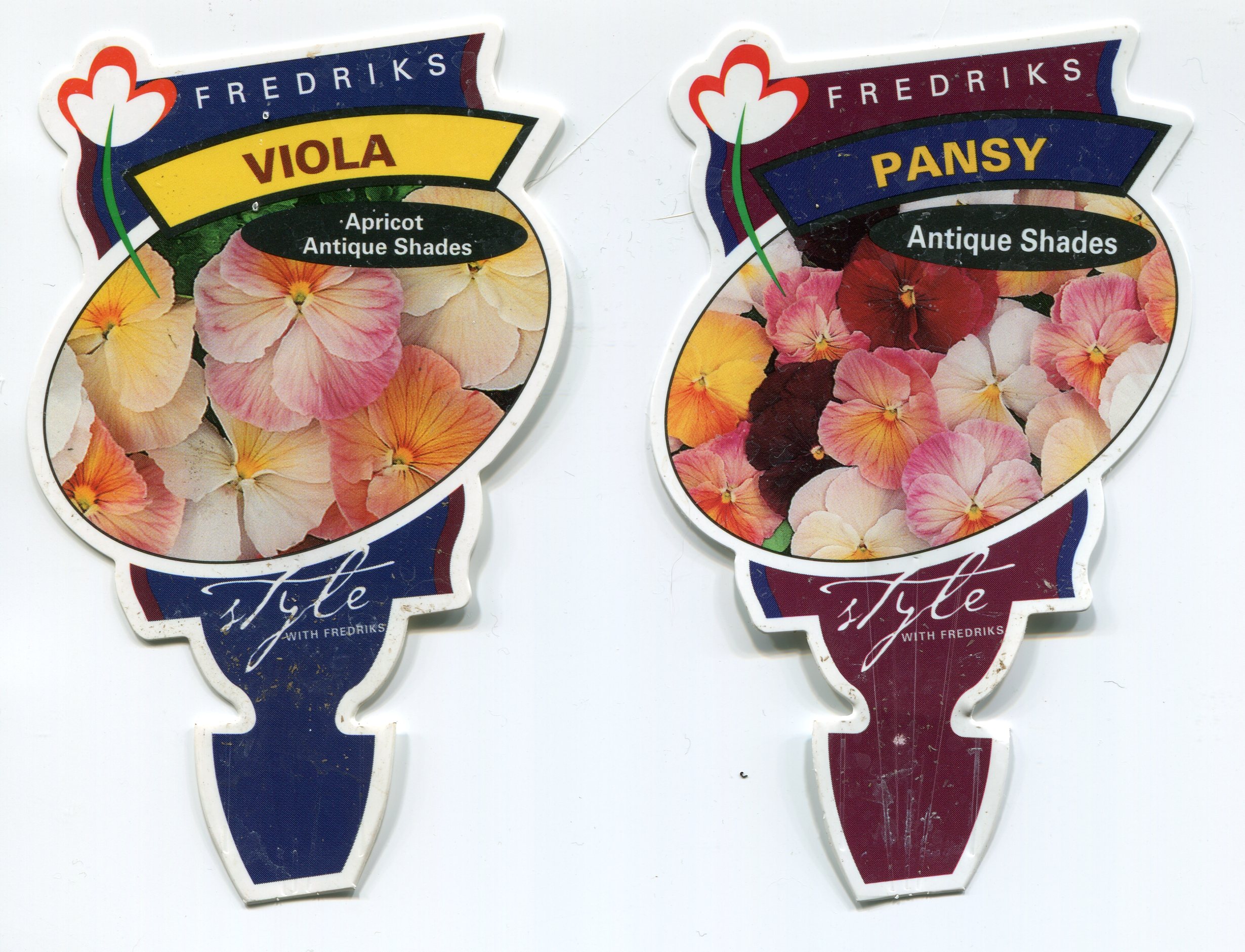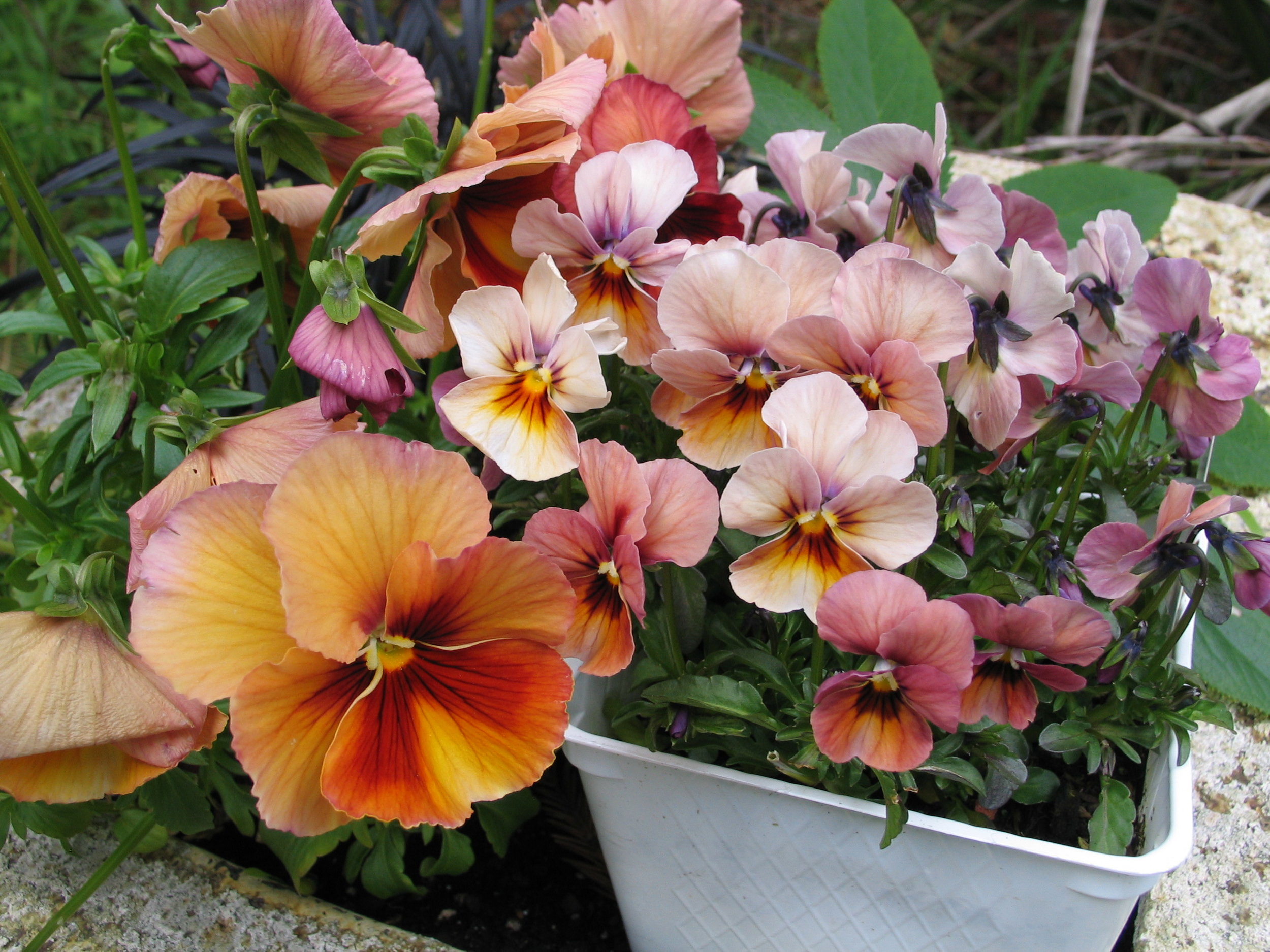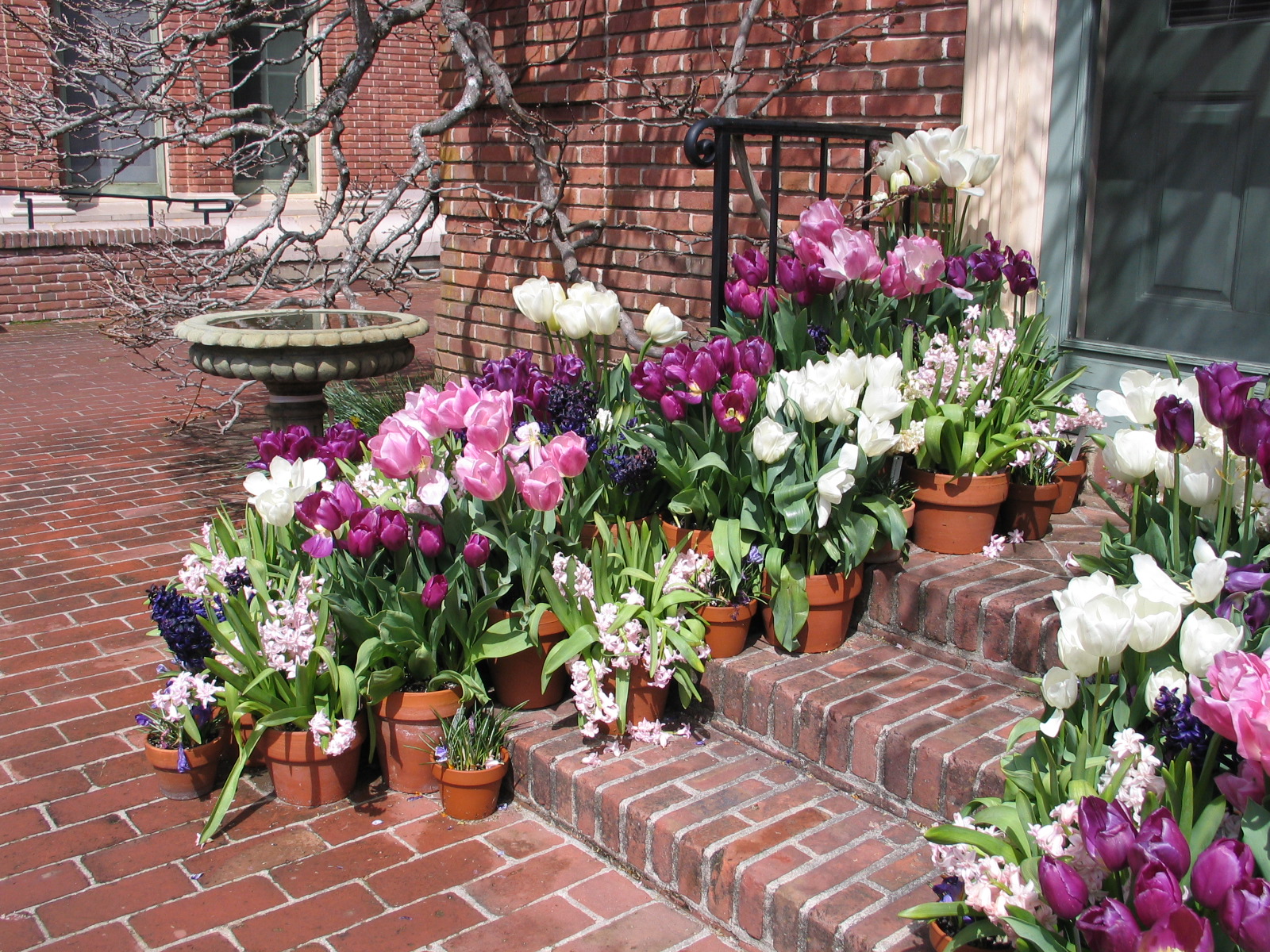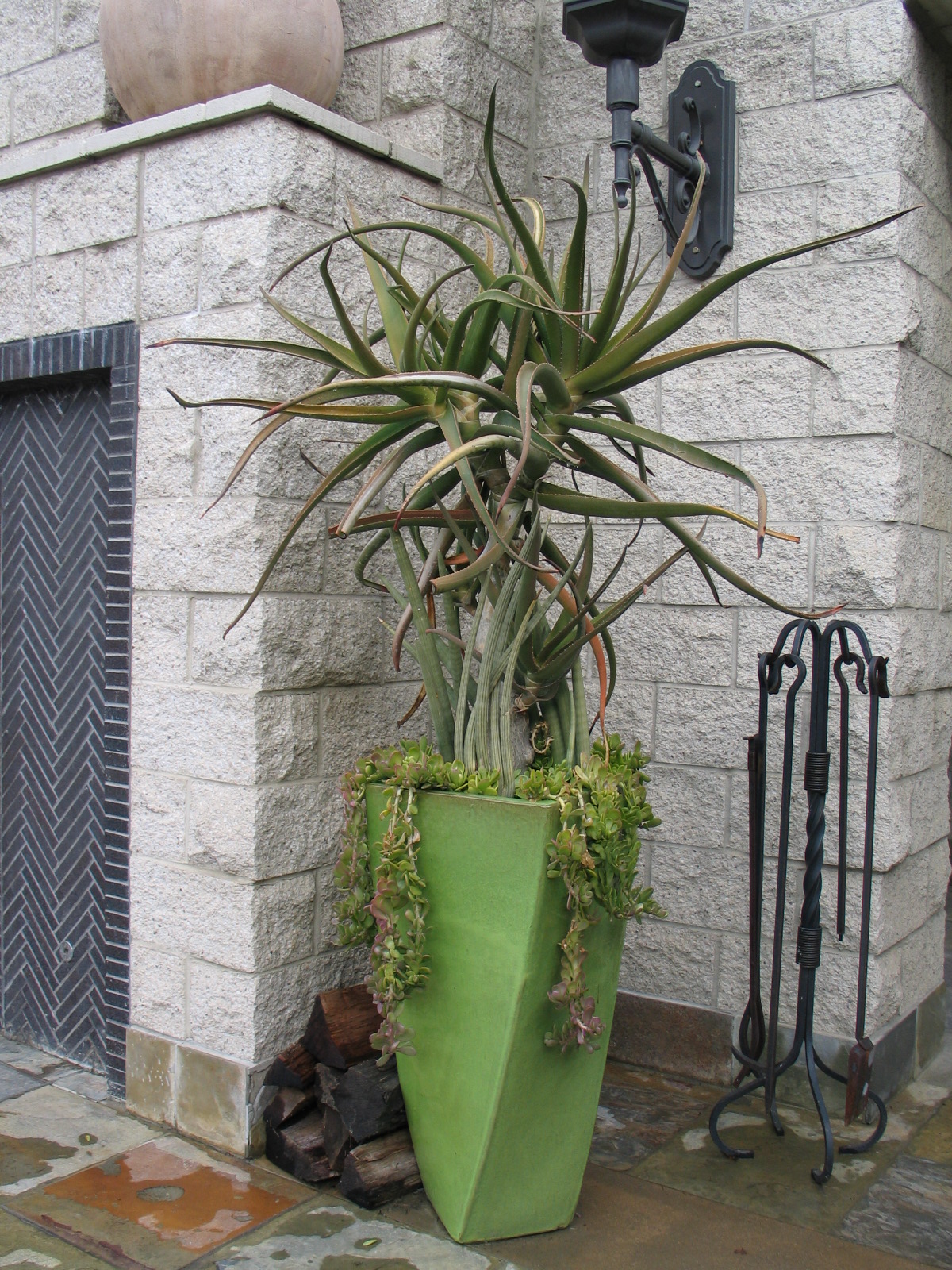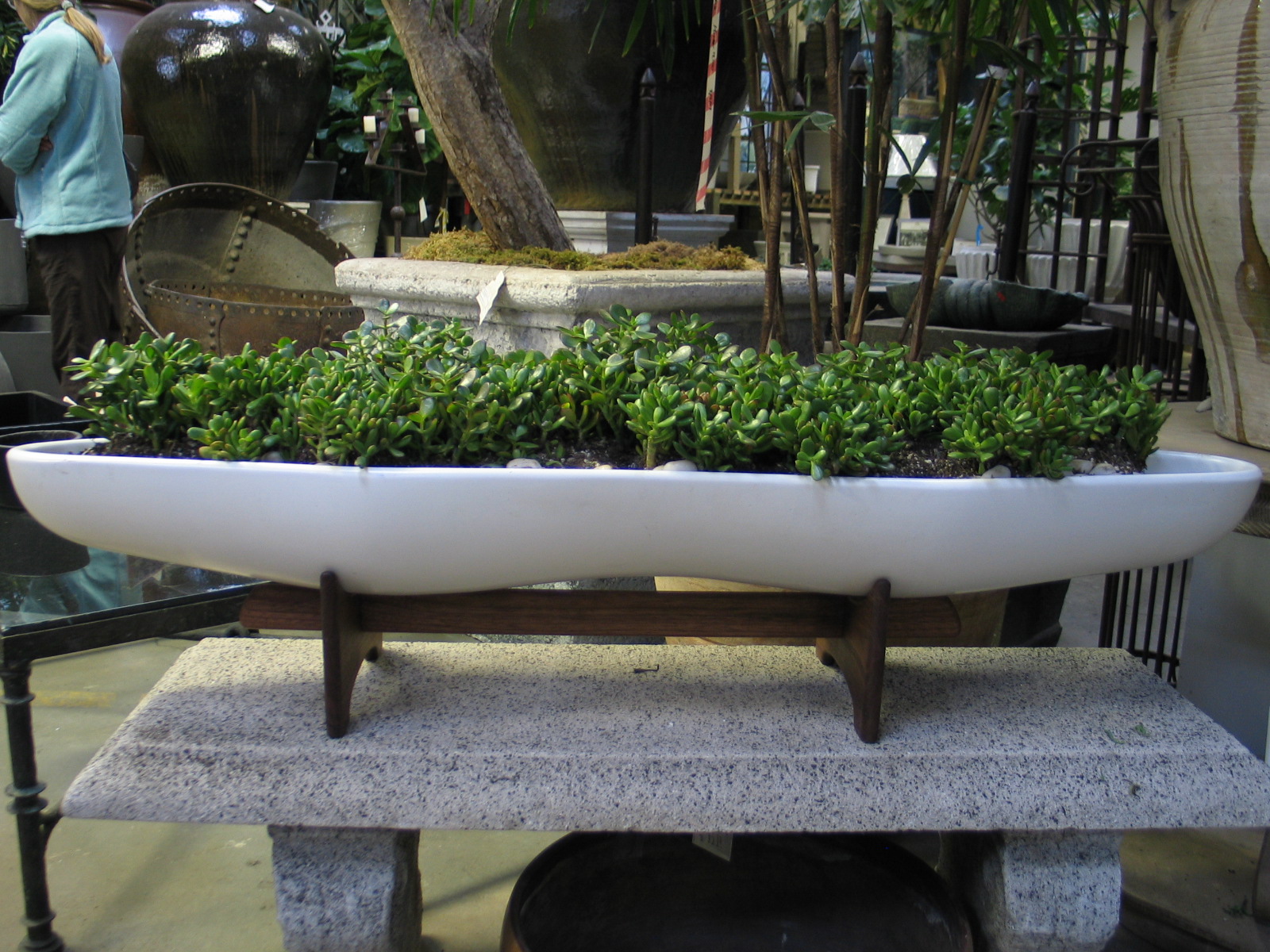Allow me to introduce you to Montalvo. If you've been reading my blog, you probably know I adore Filoli, I have posted about it a few times (March 2012, August 2010, late winter 2010) and am thinking I'll go visit again soon. However, just about half an hour drive south of there in Saratoga, CA is another impressive estate that is also open to the public (visiting this place is FREE!) Montalvo Arts Center. I visited Montalvo a few times in 2012 and attended an evening concert in 2013 and wanted to share a few images with you (yes, I AM due another visit! keep reading). Montalvo, being state owned, could always use a few more visitors. It has an incredible history and offers concerts, constantly changing artistic installations, and all sorts of festivals and events.The grounds change constantly as you'll see in the photos I'll post here and when I've visited next (familiarity with Montalvo comes thanks to my last employer, PGAdesign in Oakland):As you come up the drive, the Villa reveals itself - and in front of it is the Great Lawn (recently modified and renovated).Turning around on the great lawn you see the drive there on the left, and the entrance to the Italianate Garden.Inside the Italianate Garden (a stunner!) there are sculptures, an incredible folly, and all sorts of discoveries.Walking around the Great Lawn and up to the Villa, artistic installations are constantly changing.....and once up at the Villa, the courtyard and the former pool are flat-out lovely places to see. Do you see the pool? look again at that flat, oval lawn....those steps are more recent, but imagine the wall they're on around water...Montalvo has been undergoing renovations in the last couple of years, and I expect to return for another visit as soon as I can. Maybe this weekend? I hope so!
Marketing (or not) With My Clients' Homes
I think I did it right. I started designing gardens before I knew that was what I would "grow up" to do. My first forays into site design as a kid included a fantasy plant nursery, pet store, and flower shop. My parents' back yard was the subject of many site plans as well, though they didn't implement my thoughts.I earned my BLA (Bachelors of Landscape Architecture, a 5 year degree), got my first "real" job, and after a few years, began taking my own projects on the side. This year I started teaching and finally went full-time as my own boss. I have essentially spent all my free time for the last mumble-mumble years absorbed in design, gardens, plants, and everything related.You would think that I would have no shortage of beautiful built projects to share online, adding new ones all the time. Below is part of why I don't put a full body of work in public online places:Naturally, many of the projects I've worked on have been with former employers. Many of them are my work or at least partly so, but the former employer owns the intellectual property. I can put the work I did in my own portfolio, that is industry standard, but it is not kosher to put that stuff on my own website or blog to promote myself apart from promoting the company I worked for at the time. In addition to that, I have agreements with some former employers that state I won't put anything online that came from my employment with them, and some clients and I have similar agreements. Not marketing with clients' projects can be limiting in this age where everything is available at a click, but there ya go.I respect the wishes of my clients and some of them are more particular about their privacy than others. I never post or put online anything that a client would like to keep private. For some of them, that is everything. The work I do is often someone's home, and I totally get wanting to keep home private!Additionally, a garden is never done. The design work is only a portion of making a quality outdoor environment. A great many projects are phased in for budget reasons or other limitations (this can take years!), and it also takes time for the plants to grow in. In a recent post on a project in Italy, you can see that the photos I posted span about 2 years - after two years, that garden is just getting to the point where it looks good enough to take photos and post them. If I had posted it too early, it would not have had the same ability to represent what the intention was in the first place.I am incredibly fortunate to work on amazing projects with amazing people - whether their own home, a rental, or a commercial or institutional project, there's opportunity for discovery, beauty, and environmental benefits all around.... so am I still doing it right? I sure hope so.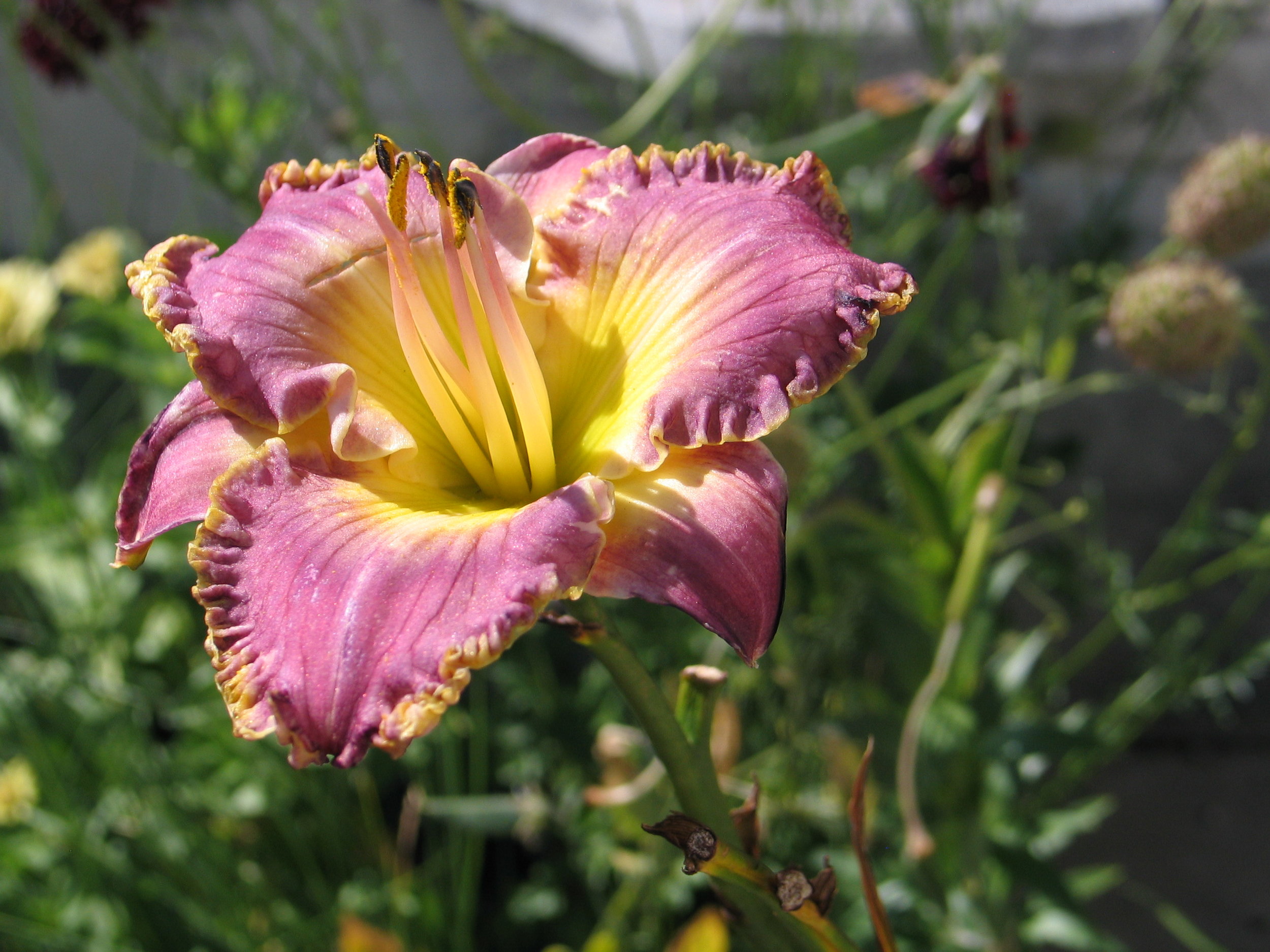
Hello, little companions!
We share the garden, period. Sharing is caring.
Read moreTrue Colors (not what the interwebs says)
I love the internet, I really do. Seriously, I rely on it for all sorts of things. None of this is new information for you, savvy reader, but here's something that drives me absolutely bananas (you know it's serious because I don't even like bananas!)Here's a screen shot of Helleborus 'Onyx odyssey' from an internet image search: 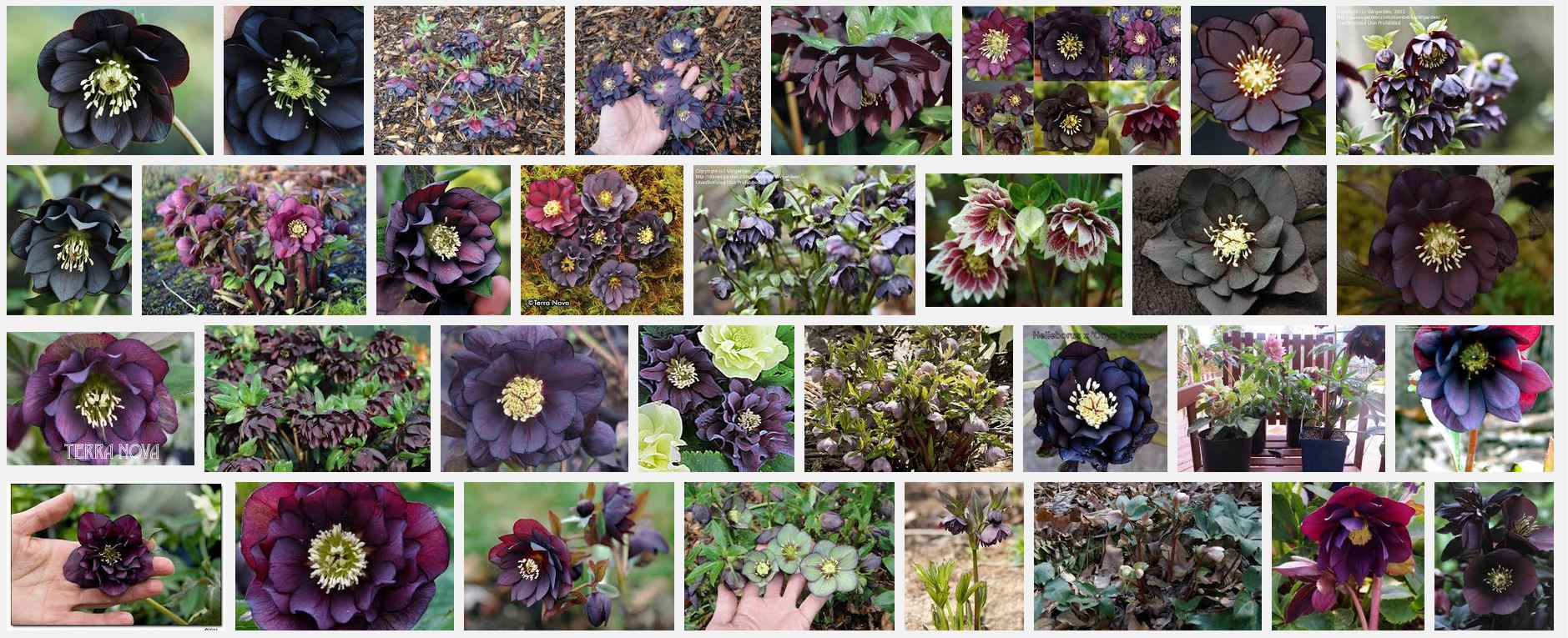 The majority of the photos above are a black or slatey near black color. From a collection like that, the black-flower-hopeful would expect that this plant was a true black or at least so ridiculously dark flowering that it didn't matter.I recognize that cameras and monitors vary in their abilities to accurately represent color, I have no issue there. My issue is more of an honor-code type thing. Below are some photos I took of this same cultivar in my old apartment patio:
The majority of the photos above are a black or slatey near black color. From a collection like that, the black-flower-hopeful would expect that this plant was a true black or at least so ridiculously dark flowering that it didn't matter.I recognize that cameras and monitors vary in their abilities to accurately represent color, I have no issue there. My issue is more of an honor-code type thing. Below are some photos I took of this same cultivar in my old apartment patio: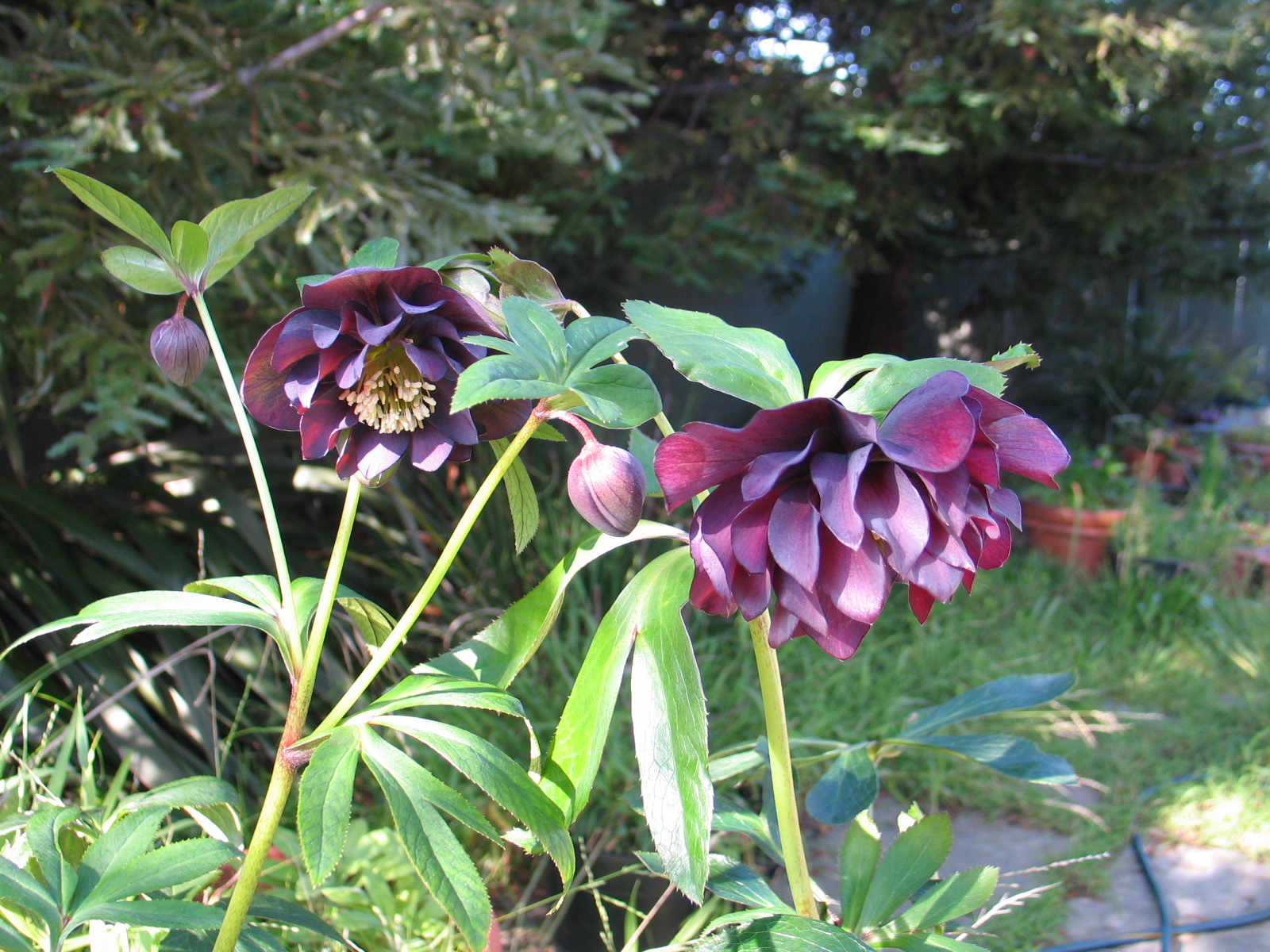
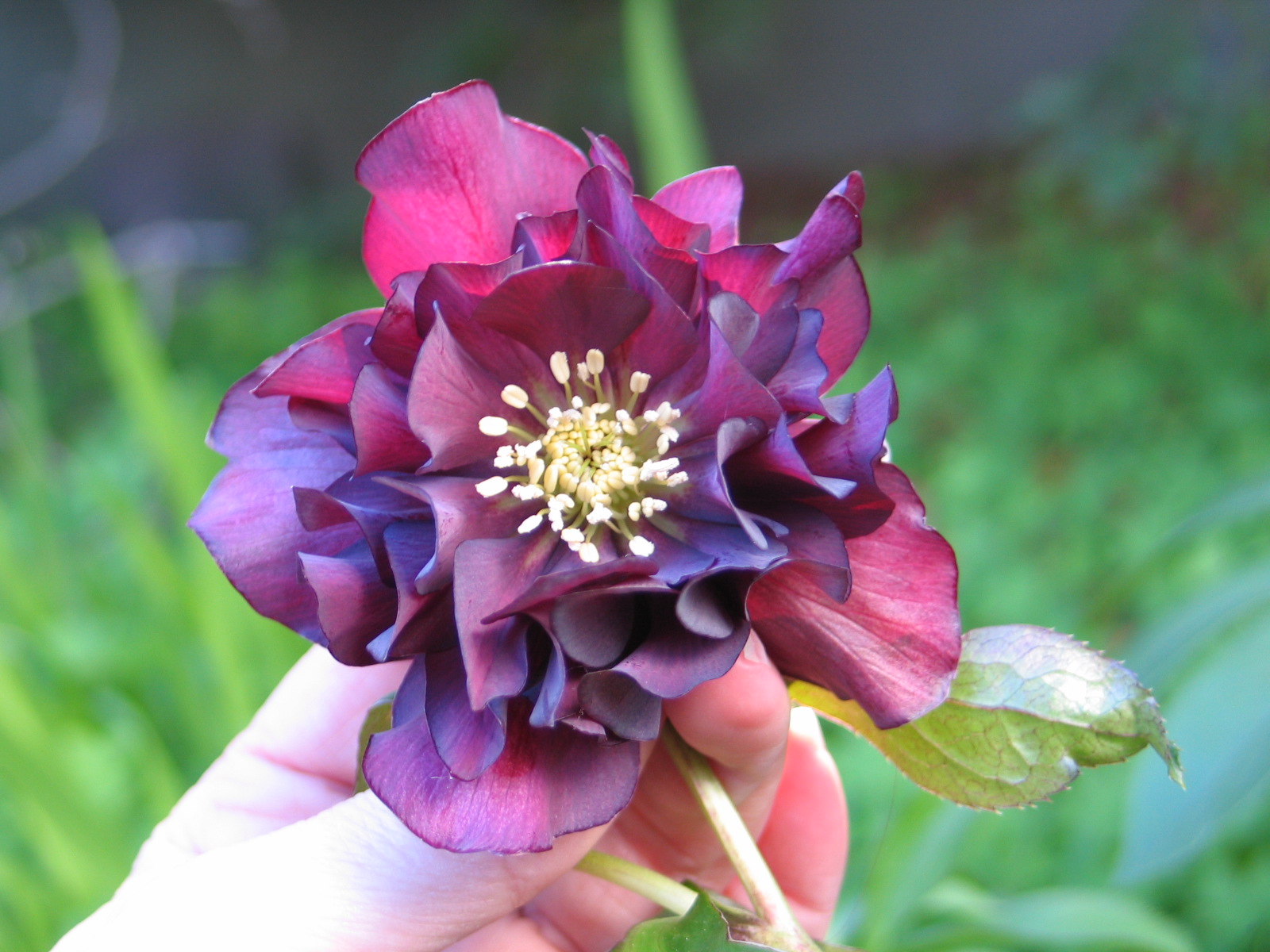
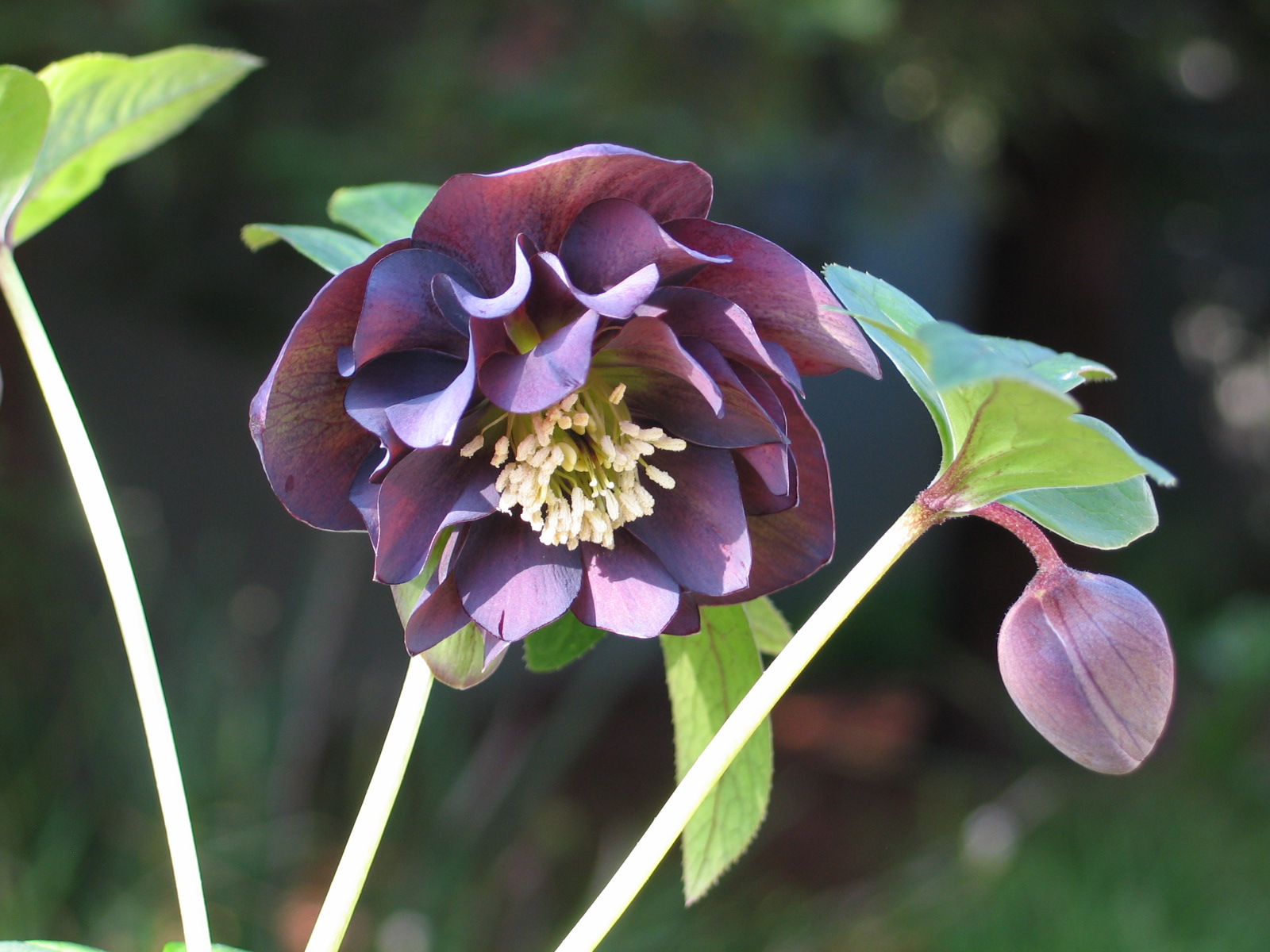 I find it important to photograph plants and flowers in the shade and the sun, and with different kinds of backgrounds and other things in the shot like ambiguous planty backgrounds and also my own hand. The camera automatically makes adjustments depending on what is in the picture - and then if I were to adjust the color in Photoshop, there are algorithms that make assumptions about what the color was supposed to be.For my design work, the internet serves as a great starting point and a place to see as many different images of the same plant as I possibly can. However, I've learned to mentally visualize colors of plants and flowers from web searches, and also to take into account the quality of the photos and the lighting.I try to grow as many different plants as I can at home (more on that later) so that I can have the best possible understanding of a plant's color and habit. I keep an extensive collection of photos that I've personally taken so I can track the same plant under as many light and growing conditions as possible, and so that I have a mind's eye recollection of each plant.My complaint, if you can really call it that, is that clients can find color-adjusted and completely unrealistic photos online, and expect that their plants will look just like that. Plants are amazing, gorgeous, living things.... but they're not always the supermodels (also usually photoshopped) that some catalogs would have us believe. Every once in a while, they become mere mortals like the rest of us. Beautiful in their own right, but not exactly as depicted.So please - don't be taken in by a great photo. Check them all. Consider before you fall in love if you're enamored with the image or the plant itself. We all deserve to be loved for who we are, sans photoshop.
I find it important to photograph plants and flowers in the shade and the sun, and with different kinds of backgrounds and other things in the shot like ambiguous planty backgrounds and also my own hand. The camera automatically makes adjustments depending on what is in the picture - and then if I were to adjust the color in Photoshop, there are algorithms that make assumptions about what the color was supposed to be.For my design work, the internet serves as a great starting point and a place to see as many different images of the same plant as I possibly can. However, I've learned to mentally visualize colors of plants and flowers from web searches, and also to take into account the quality of the photos and the lighting.I try to grow as many different plants as I can at home (more on that later) so that I can have the best possible understanding of a plant's color and habit. I keep an extensive collection of photos that I've personally taken so I can track the same plant under as many light and growing conditions as possible, and so that I have a mind's eye recollection of each plant.My complaint, if you can really call it that, is that clients can find color-adjusted and completely unrealistic photos online, and expect that their plants will look just like that. Plants are amazing, gorgeous, living things.... but they're not always the supermodels (also usually photoshopped) that some catalogs would have us believe. Every once in a while, they become mere mortals like the rest of us. Beautiful in their own right, but not exactly as depicted.So please - don't be taken in by a great photo. Check them all. Consider before you fall in love if you're enamored with the image or the plant itself. We all deserve to be loved for who we are, sans photoshop.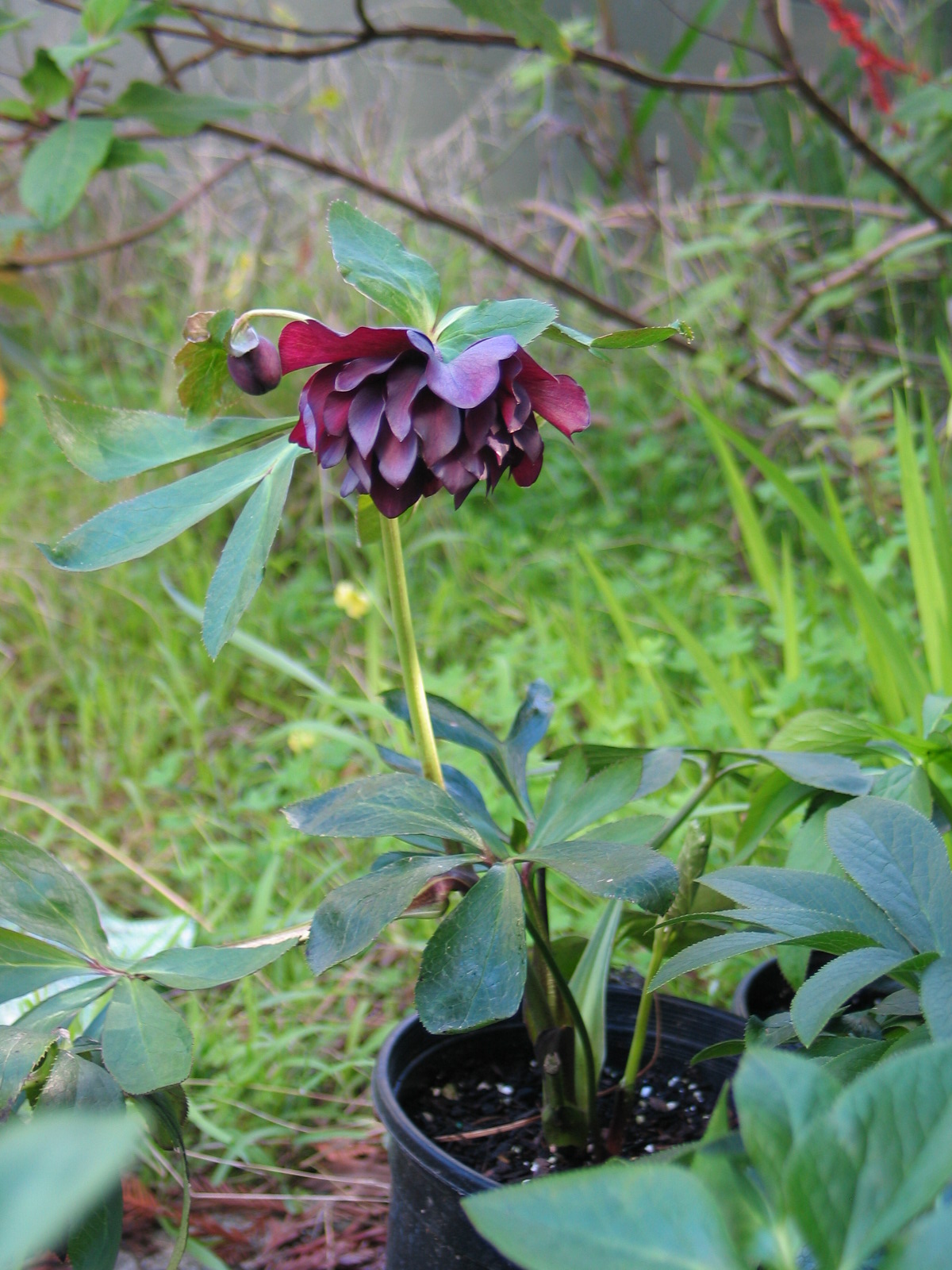
A Garden in Italy
2014 June
While I was away neglecting my modern web-presence-building duties, I enjoyed working on a particularly wonderful little project.... a Bed and Breakfast in Italy! I have never been to Italy, but when my good friend and talented architect Glenda Flaim showed me her work on Casa Incantata, I asked if I could take a stab at the planting design which had yet to be finalized. Neither of us had any idea what would happen. Come on, what do I know about plants in Italy?! Niente. The way we worked around that, and got the garden done was a genuinely collaborative effort involving Glenda, the Owners, their gardener, some dutch visitors, and me:First, Glenda sent me a photo of the site with notes (in green) on her thoughts for the planting:We chatted about the decisions on the photo - why the hedge, what is the lawn for, stuff like that. I studied snapshots of the building and tried to imagine what it would be like to be there in person. Glenda mentioned that the house had just won a national award for sustainable architecture, and was photographed soon after I started noodling with the design of the garden on paper. You can see pre-garden professional architectural photos here and here. She sent me a computer drafted file of the site and I gathered photos of plants that came to mind.I started the planting design in June 2012:I mapped out the planting design in areas with palettes. The areas got names: there was "lawn", "spicy", "meadow", and "hedge". I wrote a description of how each of these areas would be different from each other, what forms and colors I was trying to emphasize, and what colors I wanted to avoid entirely. I wrote out how these plants would change with the seasons and the desired effects. With lists of plants and their written intentions, the memos were translated into Italian and back into English through Glenda.The Owners and their gardener started looking for the plants and sent word back what was available and not, and we figured out plants that might work instead. More memos handling spacing and layout were translated back and forth, plant research was done on both continents. Plants were purchased and installed as they were found; this took a few seasons to finish. Some were purchased in Italy, some shipped from the U.S., and the last, elusive bulb was a gift from some visitors from Holland who learned of the missing bulb in discussions of the garden during their stay.Over the last 2 years, I've gotten a couple of photos a season so I could see how the garden was doing. They had wasted no time getting plants in the ground. Later that same year (fall 2012), the lawn (Hernaria glabra) which also extended between the pavers, was getting its start:By the following Spring (2013) it had filled-in very nicely!The other plants were coming along too:By that Summer, you could see the different zones expressing themselves:And just last month, I got another update:It is challenging to know how a garden will look when you're designing it, and there were many anxious moments when I knew they were investing in my advice and I could only hope that the Owners would like the results. I'm not sure it is possible to tell if the image in my head matches what the garden will become. I can't know ahead of time if the Owners will like what the garden will become, and yet it is dependent on them and everyone who takes care of it to continue to support the design's intention as the garden is maintained.I am finally able to share (two years later) how things are going here in this post. I can also share that the owners are very happy with their garden, and conveyed to me this sentiment:
Il giardino che ho sempre sognato!!!
(The garden I have always dreamed about!!!)
I couldn't have asked for more.
It's Been Too Long
Hello there! I've been away from this blog far too long. Things have been quite busy with a whole mess of life and work changes.The big news is that I moved into a new place. I'm in the very beginning stages of designing the garden here, and wanted to share with you some of the challenges I am facing and what I'm doing to make this place as useful and responsive to my needs as possible. This could take me a while, but I'm game if you are:For starters, the previous occupants planted thorny Bougainvillea next to the gate to one of the side yards. You have to squeeze by it and hope there aren't any bad guys lurking behind it to get into the rear yard. Don't catch your sleeve on the sickly, not even fragrant, and incredibly thorny patio tree rose on the left as you go:If you look behind the Bougainvillea, you'll see a very typical fence which blocks visibility into the back yard (hello again, bad guys!). A friend commented to me that it seemed wrong to block views into what will hopefully become a beautiful side yard. I have to agree! Visibility issues aside, what you can't see is that this opaque fence is nailed to the once charming original fence:Way cuter, right?! yep, I thought so too. and next is that side yard that will eventually become beautiful. Here, what you can't see are all the weed seeds that germinated the moment I moved in keeping me busy indefinitely: If you follow the side yard, you come to the back where there's some lovely painted concrete in reggae colors with teensy tiny meaningless lawns and very old, well established Photinia (one of my least favorite shrubs EVER!). How snazzy is that bit of solid fencing there? I love how it gracefully blocks the view of the neighbor's solid wall. Equally enjoyable is the brick cap on the concrete retaining walls. No lack of design consideration here:Which brings me to the shed. I love love love the shed. It has holes in the roof and sides from what appear to be buckshot so that rain drips directly on the shelf and is rotting the framing. I have no idea what that railing is for, nor why there's a flagpole footing in front of the little railing surrounded platform. I call it the pulpit. The pulpit's days are numbered; same goes for the flagpole footing and little concrete pad in front of it.In the front is an unreasonable amount of purple Lantana and this thing, probably Yucca elephantipes. It will get way too big for that little retaining wall and will break it and start all kinds of trouble in the next couple of years if I don't remove it. Sorry, Yucca, you gotta go.The good thing is that when I go to the shed and look out past the festive reggae concrete, Photinias, and strange tiny lawns, I can enjoy sunsets every night.Here's to resolving the design issues and playing in the yard!
What's in a name?
In my professional practice and in conversations outside the office, I avoid using common names for plants like the plague. It is common practice to put both scientific name and common name on a plant list, and this is so that the contractor can verify that the plant they think you're talking about is the one they've gotten for the project. Why would a contractor not be able to use scientific name and require common names as well?! As far as I can tell, the only confusion that might occur would happen when a plant has been re-classified by the trade to have a different name. For example, Ligularia changed to Farfugium years ago, but most people know it as "Leopard Plant" (regardless of the cultivar or absence of spots). Sadly, I suspect that the real reason we put common names on plant lists is because contractors don't recognize or know all the plants we might use belonging to those scientific names and they appreciate the extra hint. Residential clients often find scientific names too technical and feel more comfortable with the common names, but using common names can be very mis-leading as you'll see in the last few photos.Taking my own photos of plants is a huge benefit to me as a designer. Not only do I have the physical action of taking and naming photos to help my brain keep the connection, but I also follow some practices that help me understand the plants better for when I am designing with them in mind. Here are a couple of the things I do:Photo taking: When I am in a garden or at a nursery, I take a picture of the plant, leaf, flower (or whatever) first, then the plant tag. Plant, tag, plant, tag, plant, tag. With my trusty old digital camera, I can smash 300+ photos on one memory card at a time, and I have two memory cards. Once the plant photos are labelled with the correct scientific name, I delete the images of the plant tag. I also (usually in my own garden) take photos from different angles - a close-up of a low-growing plant from ground-level tells you nothing about what it would look like from above. A great example of this is this gorgeous specimen of Hellebore 'Pink Marble' I saw at the Annie's Annuals 2012 Summer Garden Party last weekend:Cute, huh? I am glad this person walked by at the right moment, because you can see how the plant relates to an upright person, and understand that I am sitting on the ground to take this. Now see how different it looks from above, the way you would see it in a garden (without sitting on the ground):Image file naming: I have a naming convention for the photos, too: Scientific name, then descriptive abbreviations (from my own list), followed by the abbreviation for the grower or source of the plant. For example, photos of this little Bletilla I got at Plant Delights Nursery last year are labeled "Bletilla 15in FL pdn" and Bletilla 'Murasaki Shikibu 15in FO pdn" (15in = 15 inches tall, FL = flower, FO = Form, pdn = Plant Delights Nursery):See how different the close up and the form photo look in color?! I'll take several photos of my plants because the way the camera processes color can vary a lot from image to image and depends on lighting, context, and where on the subject the camera focused. Because of this, I include other things in the picture when I can. I also use these images for inspiration for plant combinations in the future and keep copies of images in a separate "combos" folder for just that purpose. Here's a shot of the same Bletilla but with Asplenum bulbiferum (a.k.a. "Mother Fern", but you didn't hear that common name from me) in the background:Be Specific! I've already explained how I label my images, but here's a lesson from a purchase two weeks ago that I hope illustrates the need to use the whole name including the species even when it seems obvious. Take these two Violas:They look pretty similar. Both are Violas (Pansies are Violas too), both from the same grower. The big difference seems to be the name "Pansy" or "Viola" on the tag, and you might ignore this since that information is a common name thing, not scientific. The cultivar name is similar too, 'Apricot Antique Shades' vs. 'Antique Shades'. I could swear I see some of the same flowers in both photos, just turned upside down and enlarged on the Pansy tag (which is complete baloney as you'll see below). Now, flip those over and read carefully:Check that out! The Pansy's scientific name is Viola wittrockiana 'Antique Shades' and the other Viola's name is Viola cornuta 'Apricot Antique Shades. What neither of these tags tells you is how very different these two plants are in real life. The Pansy has much more orange and yellow in real life, and the smaller Viola is far pinker overall. The photo at the top of this post shows these little dudes the day I brought them home, and below I will leave you with a photo of them together in my patio while I was planting things. Thanks so much for reading, and HAPPY SPRING!So the lesson here is to not rely on catalog photos for your garden planning, take your own. Light, color, and real life differences are not always evident on plant tags or in catalogs. Designer beware!
Filoli March 2012
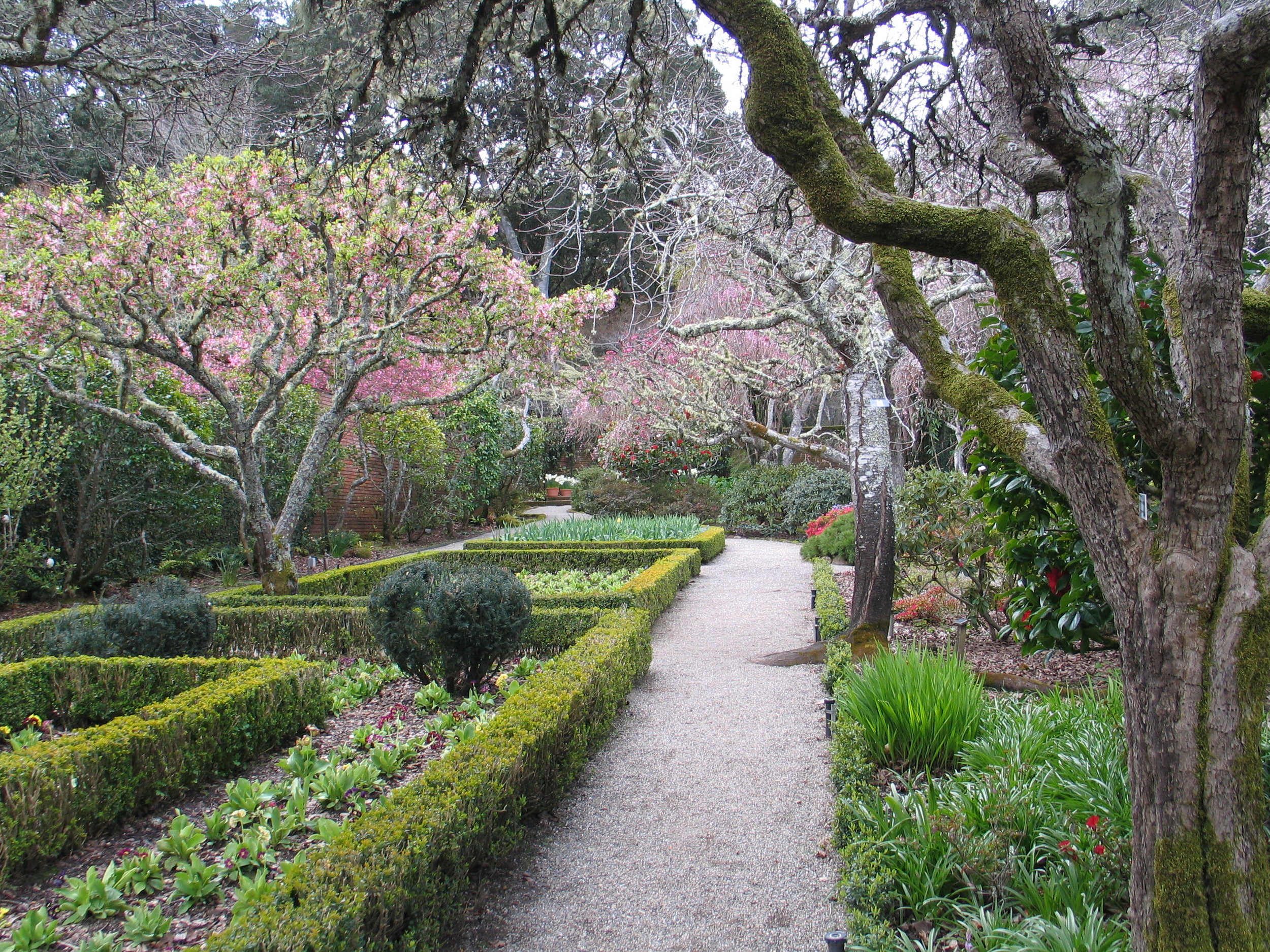 I went to Filoli AGAIN! I know, I know, I don't put up any new posts for practically a year, then I go to Filoli yet again, and start a fourth post on how awesome it is. Pretty lame, but I have a new friend (and an observation about the nursery industry) because of this particular trip.Filoli is awesome and the people watching (really, people overhearing) can't be beat. Best line of the day came from an elderly gentleman to his wife near the parking lot: "would you like me to carry your bag?". There were some ladies settled on a bench behind the main house talking about something that sounded very personal. I also enjoyed the murmurings of tour groups as they responded to their tour guide's proclamations, and a few occasions where people were clearly seeing something new to them (a double flowered daffodil confounded one woman who wondered aloud if it was really three flowers that had grown together). One visitor was wearing a pretty lavender scarf that was perfectly in tune with this planting of bulbs behind offices (near the gift shop).
I went to Filoli AGAIN! I know, I know, I don't put up any new posts for practically a year, then I go to Filoli yet again, and start a fourth post on how awesome it is. Pretty lame, but I have a new friend (and an observation about the nursery industry) because of this particular trip.Filoli is awesome and the people watching (really, people overhearing) can't be beat. Best line of the day came from an elderly gentleman to his wife near the parking lot: "would you like me to carry your bag?". There were some ladies settled on a bench behind the main house talking about something that sounded very personal. I also enjoyed the murmurings of tour groups as they responded to their tour guide's proclamations, and a few occasions where people were clearly seeing something new to them (a double flowered daffodil confounded one woman who wondered aloud if it was really three flowers that had grown together). One visitor was wearing a pretty lavender scarf that was perfectly in tune with this planting of bulbs behind offices (near the gift shop). So - while I was over here near the gift shop, I did a little poking around their plant selections and I just had to buy something that was new to me! I found a dwarf Wisteria called 'Kofuji'. It is supposedly a shrub form wisteria that will stay within 2-3' ht x sp (height by spread). I googled it and found very little information on it, but the label was from a wholesale grower, so there's hope of finding it again. I am going to stick it in a pot outside my back door and see what happens. Here's my new friend:
So - while I was over here near the gift shop, I did a little poking around their plant selections and I just had to buy something that was new to me! I found a dwarf Wisteria called 'Kofuji'. It is supposedly a shrub form wisteria that will stay within 2-3' ht x sp (height by spread). I googled it and found very little information on it, but the label was from a wholesale grower, so there's hope of finding it again. I am going to stick it in a pot outside my back door and see what happens. Here's my new friend: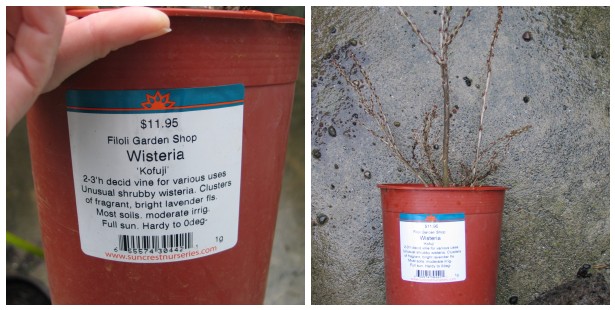 Here's what I'm getting to: I've had my own garden on my mind lately (as well as those of clients), and have been visiting local nurseries to see what is interesting. I depend on nurseries to carry a wide variety of plants including the newer introductions so that I can take pictures for my clients (especially of certain plants together!) and test grow stuff in my patio, see how they do, get to know them personally. I like to think that through this process, I can not only suggest the exact cultivar I would propose for their project, but also have a reasonable expectation of being able to secure that plant when the time comes. Unfortunately, even though my new Wisteria friend originated at a well known wholesale grower, I had to go all the way across the bay to Filoli to discover it.Sadly, nurseries have been struggling along with the rest of the design and construction industries for the last few years. Last year, I noticed that they were under-staffed, under-stocked, and had extended seasonal closures. This year, what I am noticing is a lack of variety and larger materials. They're selling old standbys in smaller sizes and have reduced or eliminated the expense of ordering from a wider number of growers and also are not putting as much effort into creating big displays that I am sure ate up some money for them in the past (but was probably worth it when people were buying!). They seem to be avoiding the riskiness of bringing in less commonly known plants. I can't usually leave a nursery without buying something, but this spring, I've been through several - the Wisteria is the first plant I bought this year - which is saying something!So please - go and show your local nursery some love (not Home Depot). Buy a small plant or some seeds, let them know you're still out there. Your community and your garden will thank you. Meanwhile, here's some more of the wonderfulness that is Filoli:
Here's what I'm getting to: I've had my own garden on my mind lately (as well as those of clients), and have been visiting local nurseries to see what is interesting. I depend on nurseries to carry a wide variety of plants including the newer introductions so that I can take pictures for my clients (especially of certain plants together!) and test grow stuff in my patio, see how they do, get to know them personally. I like to think that through this process, I can not only suggest the exact cultivar I would propose for their project, but also have a reasonable expectation of being able to secure that plant when the time comes. Unfortunately, even though my new Wisteria friend originated at a well known wholesale grower, I had to go all the way across the bay to Filoli to discover it.Sadly, nurseries have been struggling along with the rest of the design and construction industries for the last few years. Last year, I noticed that they were under-staffed, under-stocked, and had extended seasonal closures. This year, what I am noticing is a lack of variety and larger materials. They're selling old standbys in smaller sizes and have reduced or eliminated the expense of ordering from a wider number of growers and also are not putting as much effort into creating big displays that I am sure ate up some money for them in the past (but was probably worth it when people were buying!). They seem to be avoiding the riskiness of bringing in less commonly known plants. I can't usually leave a nursery without buying something, but this spring, I've been through several - the Wisteria is the first plant I bought this year - which is saying something!So please - go and show your local nursery some love (not Home Depot). Buy a small plant or some seeds, let them know you're still out there. Your community and your garden will thank you. Meanwhile, here's some more of the wonderfulness that is Filoli:
Pinterest and Design Communication
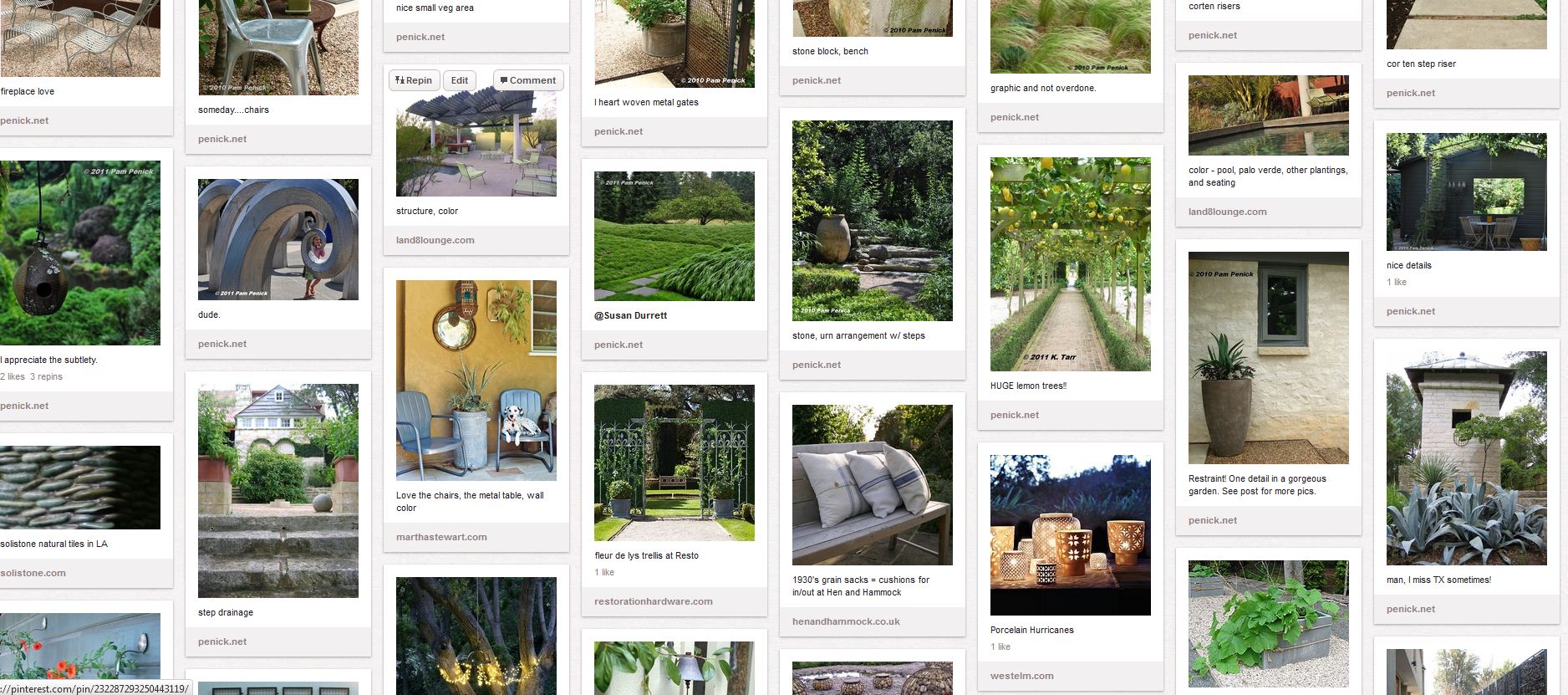 It never occurred to me until recently to use Pinterest.com as a communication tool in collaboration with a client. Granted, Pinterest can’t actually do the design work for me or my client, but it does allow for us to collaborate and understand each other in a common forum....which is proving to be so fun!Pinterest isn’t everyone's favorite tool, but for those who want to collect images and links in a web-based place, it is a lot of fun. Back in the day (like a year ago), I saved links as internet explorer's bookmarks and images were always saved to my hard-drive (which means I don't know where they came from). Now, I have links for non image-heavy things (like articles) on Delicious.com and images (with links!) are on Pinterest. I can access all this stuff as a resource from anywhere there's internet access. That's kinda handy! (What Pinterest is)I’ve only just tried using it with a client recently, and at one of our meetings, I asked what they thought. So far, so good – my client likes being able to share a photo with me, and we add comments back and forth for each other. It is so gratifying to see that my client has started a board for their project, and have “re-pinned” some “pins” from my various boards (with comments!) which helps me zero-in on exactly what they’re responding to.People can "pin" images from anywhere on the internet, and they can also upload images from their own computer... but don't mistake someone's pins for their own design ability or experience. The images come from all over the place, with and without express permission. There is some concern over permissions and Pinterest's user agreement. Several months ago, I did have the experience of re-pinning an image and then getting an email from Pinterest that the owner of that image had requested it be taken down, so they emailed me a link to the source and removed the image from every instance on Pinterest.So- if you're planning a project, or looking for an easier way to share images with your client or designer than saving and e-mailing both a link and the picture, this may be a useful thing for you!If you want to follow my boards, go ahead. I take no credit for the work you see there, though, unless expressly noted as my own.
It never occurred to me until recently to use Pinterest.com as a communication tool in collaboration with a client. Granted, Pinterest can’t actually do the design work for me or my client, but it does allow for us to collaborate and understand each other in a common forum....which is proving to be so fun!Pinterest isn’t everyone's favorite tool, but for those who want to collect images and links in a web-based place, it is a lot of fun. Back in the day (like a year ago), I saved links as internet explorer's bookmarks and images were always saved to my hard-drive (which means I don't know where they came from). Now, I have links for non image-heavy things (like articles) on Delicious.com and images (with links!) are on Pinterest. I can access all this stuff as a resource from anywhere there's internet access. That's kinda handy! (What Pinterest is)I’ve only just tried using it with a client recently, and at one of our meetings, I asked what they thought. So far, so good – my client likes being able to share a photo with me, and we add comments back and forth for each other. It is so gratifying to see that my client has started a board for their project, and have “re-pinned” some “pins” from my various boards (with comments!) which helps me zero-in on exactly what they’re responding to.People can "pin" images from anywhere on the internet, and they can also upload images from their own computer... but don't mistake someone's pins for their own design ability or experience. The images come from all over the place, with and without express permission. There is some concern over permissions and Pinterest's user agreement. Several months ago, I did have the experience of re-pinning an image and then getting an email from Pinterest that the owner of that image had requested it be taken down, so they emailed me a link to the source and removed the image from every instance on Pinterest.So- if you're planning a project, or looking for an easier way to share images with your client or designer than saving and e-mailing both a link and the picture, this may be a useful thing for you!If you want to follow my boards, go ahead. I take no credit for the work you see there, though, unless expressly noted as my own.
Dahlias
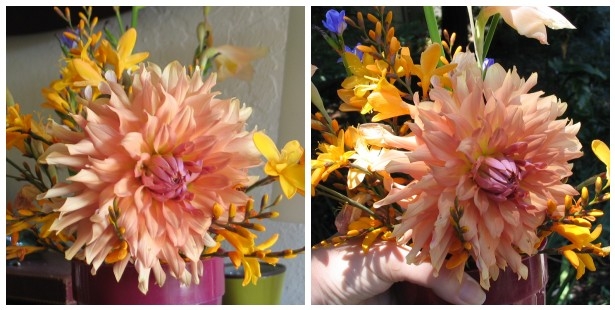 My poor Dahlia of unknown cultivar (above) died. My mom gave it to me, she said it would be easy to grow. I put it in a pot and it grew, then I thought it might like more consistent watering, so I planted it in the ground thinking 'hey, all plants prefer the ground to pots!'. Wrong-o. I have to admit, this is one plant that even I won't argue is "low maintenance".Rot. I learned how I killed my Dahlia when I went to Flora Grubb Gardens over the weekend to hear a talk given by the gregarious Mike Schelp of The Dahlia Farm (cut flower grower) in Half Moon Bay. What follows are my notes, posted here to help keep more Dahlias safe from harm:Climate and lifting: In colder parts of the country, Dahlias need to be lifted because they are frost tender. Where frost isn't a problem, they should still be lifted and divided because their tubers are both incredibly prolific and prone to rot. They don't like too much heat, either, so mild coastal climates are really great for them.Sun Exposure: Since they're not keen on very high temperatures, if you live in a warmer area, consider protecting them from full sun (or at least afternoon hot sun). The color of the flowers can be "bleached out" by strong sun exposure, so if a normally deeply colored cultivar is not living up to your expectations, this might be the culprit (or it could be any number of other things as they can be pretty variable).Soil: Dahlias like a light, slightly acidic soil that is well drained (so raised beds, containers, or in a well drained location). Containers should be at least a 5 gal. size.Water: Dahlias like moderate water when they are actively growing, but will rot out easily. In the container, mine had pretty good drainage, but one wet spring in the ground was enough to kill it. Mr. Schelp grows his in semi-raised beds for this reason, and he usually does his dividing in January (so they get lifted and divided EVERY year!). Be aware that if you grow yours in a container, that moisture can collect at the bottom, causing (you guessed it)....rot.Pests: They're susceptible to all the bad bugs and also to mildew. There was a lively discussion of mildew which I won't bore you with, but let's just say it can be a serious problem for some cultivars and any affected leaves should be removed immediately. The tubers are gopher candy, so he recommends that if you have gophers, plant the tubers in a wire mesh "cage" about 15" diameter with an un-attached bottom for easy lifting.Air Circulation: oh my! Mildew can be such a problem that he recommends a few things to keep the air flowing. Pinch off leaves in the bottom 6" of the plant to allow air to flow at the base. Take away stems or leaves that make the plant too bushy for air to circulate. Plant tubers 30 inches apart to keep the air flowing between individual plants.Feeding: This is one place where I did not entirely agree with the presenter. He is a cut flower grower, so his needs are different from mine. He uses chemical fertilizers (which kill good microbes in the soil). I wrote down that he recommends a high Nitrogen fertilizer beginning when the plants start coming up. That application should be applied, diluted, throughout the season, not at once, and taper off towards the end of the season or the Nitrogen will rot your tubers. He also switches to a higher Phosphorous fertilizer when the plants are starting to bloom. I will be experimenting with not doing this, opting instead for an organic approach (coffee grounds, anyone?). Dahlias are surface feeders, so apply nutrients accordingly, but be careful not to use too much to avoid scorching them chemically.Propagation: Dahlias can be propagated by several methods, too many to go into detail here. So I found someone else who covered this information HERE. A happy Dahlia tuber can multiply ten fold in one growing season, provided you don't rot it. Plant tubers 2-6" deep, but DO NOT let the "neck" break. A tuber with a broken neck is toast.Availability: Most garden centers sell Dahlias as tubers between winter and spring or as green plants during the summer. You can find them by mail order between (give or take) December and March, tubers should be back in the ground around April.Cut flowers: If you are still brave enough to grow them, you can keep cut flowers for about a week. I was impressed that his cut flowers are delivered to a local florist no more than two hours after being cut on the farm. I only wish he had said what florist! Here's how you can do it: cut the stem and dip immediately in hot water for about an hour (hot so you could wash your hands in it, but not boil an egg). Re-cut the stem at least every other day and place in tepid water (doesn't have to be hot anymore). Remove browning petals as flowers fade, keep flowers away from produce (ethylene gas from ripening produce speeds the aging of the flowers!). Keep your flowers in a cool room, away from direct sun. If you are cutting flowers for general enjoyment in a vase, cut them when the bud has begun to open but the center is still tight - an unopened bud will not open in the vase. If you are cutting for a specific event, wait until the flowers are at their peak before cutting. They won't last as long, but they will be gorgeous.Still not dissuaded from wanting to grow Dahlias? Me neither. This fall I plan to order a Dahlia tuber or two and try again, this time in a bigger pot with better drainage and more understanding. To find my new green friend, I will attend the 2011 American Dahlia Society show at the Santa Clara Convention Center this August. Show admission is free to the public on the 20th and 21st. I will write down the names of the cultivars I like and use the Colorado Dahlia Society's "Big List" to find a supplier for my favorites.At the end of the discussion, Mr. Schelp added what seemed to be a very personal note. He asked the audience to give away their extra plants and flowers. If grown well, you are bound to have extra and sharing is the best way to pass around some good vibes. He asked that we give our flowers to hospice centers and old folks homes, friends and neighbors. His voice quavered just enough that I could hear it in the front row, and I believe that this was a very personally meaningful message he was trying to send, so I repeat it here. I plan to do the same with my new Dahlias and I urge you to do the same.
My poor Dahlia of unknown cultivar (above) died. My mom gave it to me, she said it would be easy to grow. I put it in a pot and it grew, then I thought it might like more consistent watering, so I planted it in the ground thinking 'hey, all plants prefer the ground to pots!'. Wrong-o. I have to admit, this is one plant that even I won't argue is "low maintenance".Rot. I learned how I killed my Dahlia when I went to Flora Grubb Gardens over the weekend to hear a talk given by the gregarious Mike Schelp of The Dahlia Farm (cut flower grower) in Half Moon Bay. What follows are my notes, posted here to help keep more Dahlias safe from harm:Climate and lifting: In colder parts of the country, Dahlias need to be lifted because they are frost tender. Where frost isn't a problem, they should still be lifted and divided because their tubers are both incredibly prolific and prone to rot. They don't like too much heat, either, so mild coastal climates are really great for them.Sun Exposure: Since they're not keen on very high temperatures, if you live in a warmer area, consider protecting them from full sun (or at least afternoon hot sun). The color of the flowers can be "bleached out" by strong sun exposure, so if a normally deeply colored cultivar is not living up to your expectations, this might be the culprit (or it could be any number of other things as they can be pretty variable).Soil: Dahlias like a light, slightly acidic soil that is well drained (so raised beds, containers, or in a well drained location). Containers should be at least a 5 gal. size.Water: Dahlias like moderate water when they are actively growing, but will rot out easily. In the container, mine had pretty good drainage, but one wet spring in the ground was enough to kill it. Mr. Schelp grows his in semi-raised beds for this reason, and he usually does his dividing in January (so they get lifted and divided EVERY year!). Be aware that if you grow yours in a container, that moisture can collect at the bottom, causing (you guessed it)....rot.Pests: They're susceptible to all the bad bugs and also to mildew. There was a lively discussion of mildew which I won't bore you with, but let's just say it can be a serious problem for some cultivars and any affected leaves should be removed immediately. The tubers are gopher candy, so he recommends that if you have gophers, plant the tubers in a wire mesh "cage" about 15" diameter with an un-attached bottom for easy lifting.Air Circulation: oh my! Mildew can be such a problem that he recommends a few things to keep the air flowing. Pinch off leaves in the bottom 6" of the plant to allow air to flow at the base. Take away stems or leaves that make the plant too bushy for air to circulate. Plant tubers 30 inches apart to keep the air flowing between individual plants.Feeding: This is one place where I did not entirely agree with the presenter. He is a cut flower grower, so his needs are different from mine. He uses chemical fertilizers (which kill good microbes in the soil). I wrote down that he recommends a high Nitrogen fertilizer beginning when the plants start coming up. That application should be applied, diluted, throughout the season, not at once, and taper off towards the end of the season or the Nitrogen will rot your tubers. He also switches to a higher Phosphorous fertilizer when the plants are starting to bloom. I will be experimenting with not doing this, opting instead for an organic approach (coffee grounds, anyone?). Dahlias are surface feeders, so apply nutrients accordingly, but be careful not to use too much to avoid scorching them chemically.Propagation: Dahlias can be propagated by several methods, too many to go into detail here. So I found someone else who covered this information HERE. A happy Dahlia tuber can multiply ten fold in one growing season, provided you don't rot it. Plant tubers 2-6" deep, but DO NOT let the "neck" break. A tuber with a broken neck is toast.Availability: Most garden centers sell Dahlias as tubers between winter and spring or as green plants during the summer. You can find them by mail order between (give or take) December and March, tubers should be back in the ground around April.Cut flowers: If you are still brave enough to grow them, you can keep cut flowers for about a week. I was impressed that his cut flowers are delivered to a local florist no more than two hours after being cut on the farm. I only wish he had said what florist! Here's how you can do it: cut the stem and dip immediately in hot water for about an hour (hot so you could wash your hands in it, but not boil an egg). Re-cut the stem at least every other day and place in tepid water (doesn't have to be hot anymore). Remove browning petals as flowers fade, keep flowers away from produce (ethylene gas from ripening produce speeds the aging of the flowers!). Keep your flowers in a cool room, away from direct sun. If you are cutting flowers for general enjoyment in a vase, cut them when the bud has begun to open but the center is still tight - an unopened bud will not open in the vase. If you are cutting for a specific event, wait until the flowers are at their peak before cutting. They won't last as long, but they will be gorgeous.Still not dissuaded from wanting to grow Dahlias? Me neither. This fall I plan to order a Dahlia tuber or two and try again, this time in a bigger pot with better drainage and more understanding. To find my new green friend, I will attend the 2011 American Dahlia Society show at the Santa Clara Convention Center this August. Show admission is free to the public on the 20th and 21st. I will write down the names of the cultivars I like and use the Colorado Dahlia Society's "Big List" to find a supplier for my favorites.At the end of the discussion, Mr. Schelp added what seemed to be a very personal note. He asked the audience to give away their extra plants and flowers. If grown well, you are bound to have extra and sharing is the best way to pass around some good vibes. He asked that we give our flowers to hospice centers and old folks homes, friends and neighbors. His voice quavered just enough that I could hear it in the front row, and I believe that this was a very personally meaningful message he was trying to send, so I repeat it here. I plan to do the same with my new Dahlias and I urge you to do the same.
Plant Delights Nursery Open House
I was delighted to have had the opportunity to visit Plant Delights Nursery and their Juniper Level Botanical Garden last week. There is SO much to love, but sadly very few decent photos. You see, that day was the first day of their Open House, but my last day in the area. I had only two hours before I had to leave for my flight, and a measly 36 image slots left on my camera's memory card (not nearly enough!). I didn't want to skip shopping, so I had to keep moving....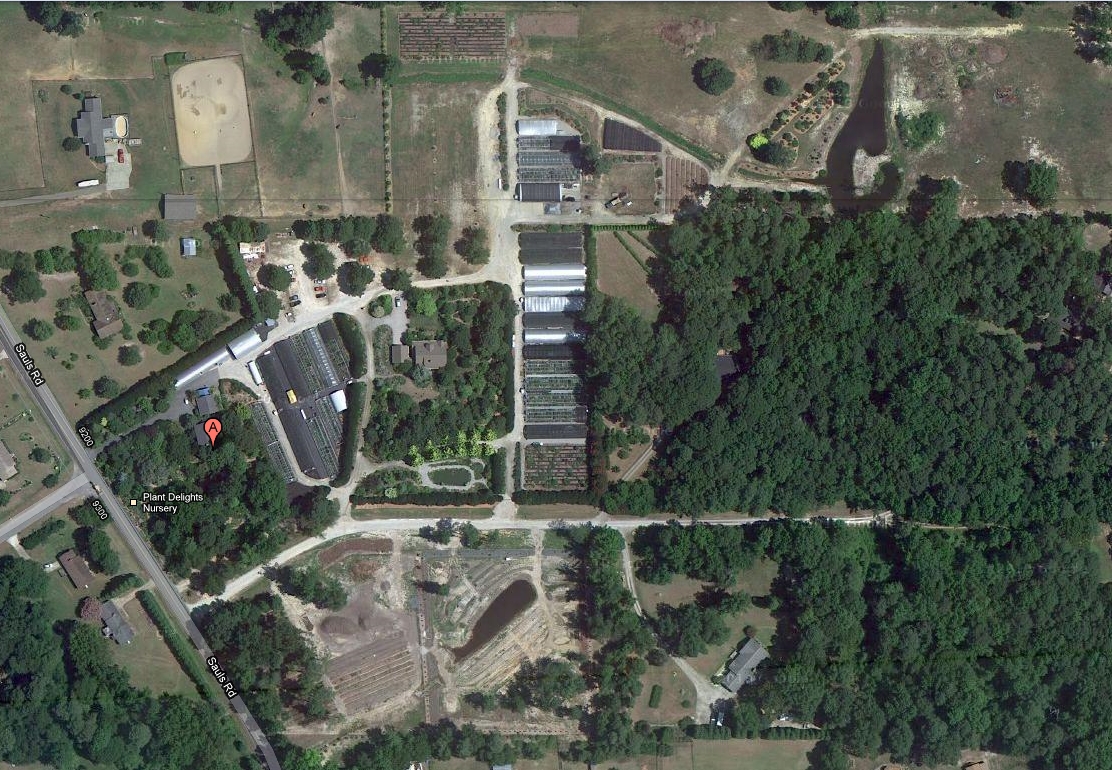 Let me start here: I've been reading Tony Avent's (the proprietor) e-mail newsletter and ordering from his mail order catalog for years. I read his book in college, and meeting him was (for doofy plant geek me) akin to meeting a movie star. Let me tell you - HE KNOWS HIS STUFF. Even though he lives in North Carolina, that dude is up to speed on Bay Area nurseries and gardens (including news items I wouldn't know about if I wasn't a member of the HALS North CA chapter). Despite having hundreds (think I'm kidding? you should've seen the big tour busses) of people wandering about, he spent a nice chunk of time chatting with me about gardens and nurseries in the Bay Area.
Let me start here: I've been reading Tony Avent's (the proprietor) e-mail newsletter and ordering from his mail order catalog for years. I read his book in college, and meeting him was (for doofy plant geek me) akin to meeting a movie star. Let me tell you - HE KNOWS HIS STUFF. Even though he lives in North Carolina, that dude is up to speed on Bay Area nurseries and gardens (including news items I wouldn't know about if I wasn't a member of the HALS North CA chapter). Despite having hundreds (think I'm kidding? you should've seen the big tour busses) of people wandering about, he spent a nice chunk of time chatting with me about gardens and nurseries in the Bay Area.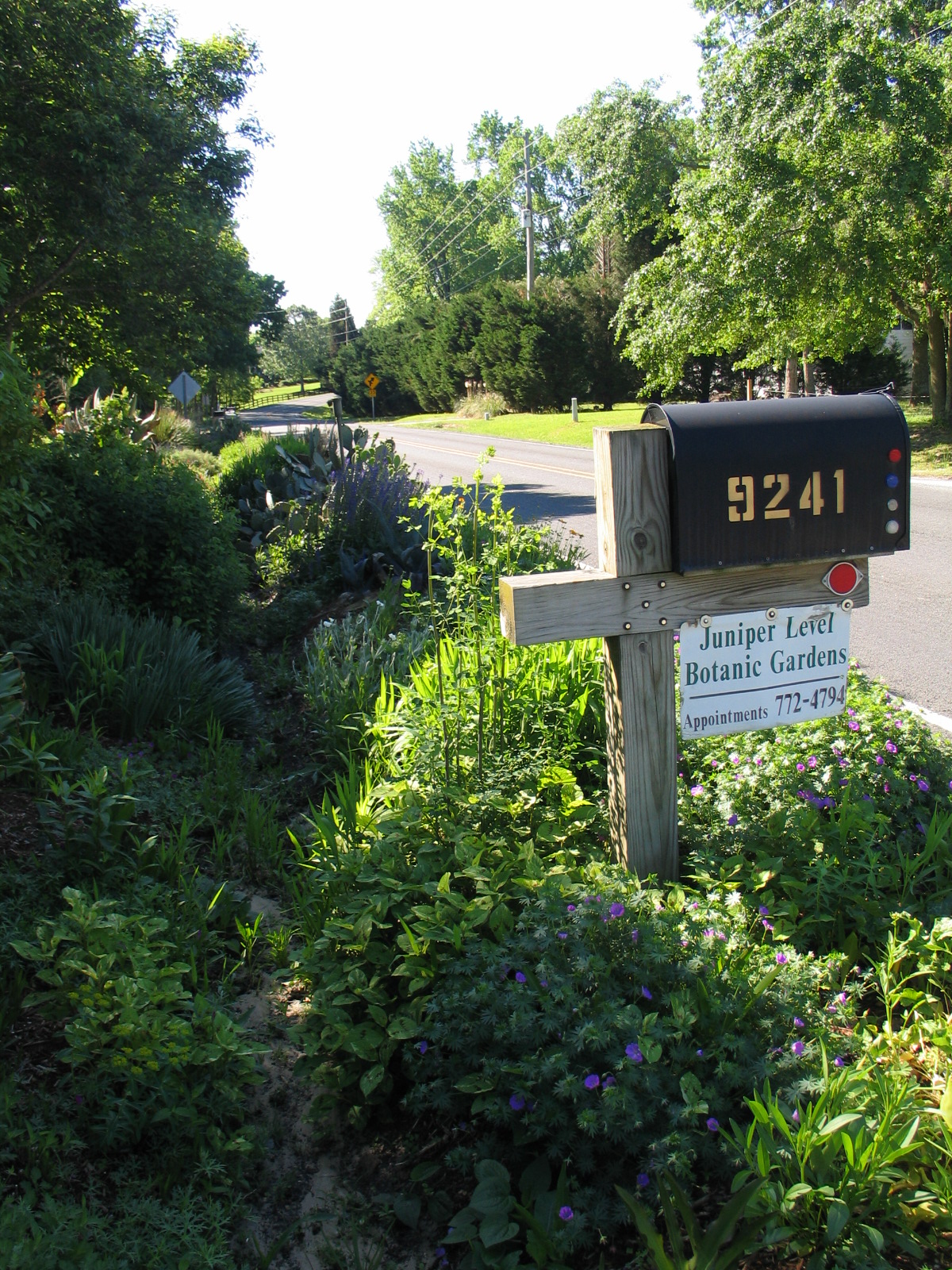 His staff were equally accommodating, and this is the main reason I am posting about the trip. I cannot emphasize enough how remarkable the staff is. I met/talked to no less than six people, each of them asked me if it was my first time at the gardens, and where was I visiting from. When I saw that person again, they made sure to make eye contact, wave, smile, or otherwise say something like "hey, you still here?", "what plant are you getting now?" or "have a safe flight!". I bought only THREE plants, all in 4" containers, so it wasn't like I was being recognized for pigging out on the greenery. I bought an Arisaema (I've never grown this before, so we'll see if Tony was right and it likes my patio) that had been rooted in the pot next to it, so when they were picked up, each had exposed roots. I went to pay for it, and the nice man who wrote up my sales ticket directed me into one of their holding/shipping greenhouses so he could nest the 4" pot into a 2 gal pot with potting soil to protect those roots until I could get it home and safely re-potted. There was no extra charge for this, but it sure illustrates how much they care about the plants and what they'll do to make sure they aren't compromised.
His staff were equally accommodating, and this is the main reason I am posting about the trip. I cannot emphasize enough how remarkable the staff is. I met/talked to no less than six people, each of them asked me if it was my first time at the gardens, and where was I visiting from. When I saw that person again, they made sure to make eye contact, wave, smile, or otherwise say something like "hey, you still here?", "what plant are you getting now?" or "have a safe flight!". I bought only THREE plants, all in 4" containers, so it wasn't like I was being recognized for pigging out on the greenery. I bought an Arisaema (I've never grown this before, so we'll see if Tony was right and it likes my patio) that had been rooted in the pot next to it, so when they were picked up, each had exposed roots. I went to pay for it, and the nice man who wrote up my sales ticket directed me into one of their holding/shipping greenhouses so he could nest the 4" pot into a 2 gal pot with potting soil to protect those roots until I could get it home and safely re-potted. There was no extra charge for this, but it sure illustrates how much they care about the plants and what they'll do to make sure they aren't compromised.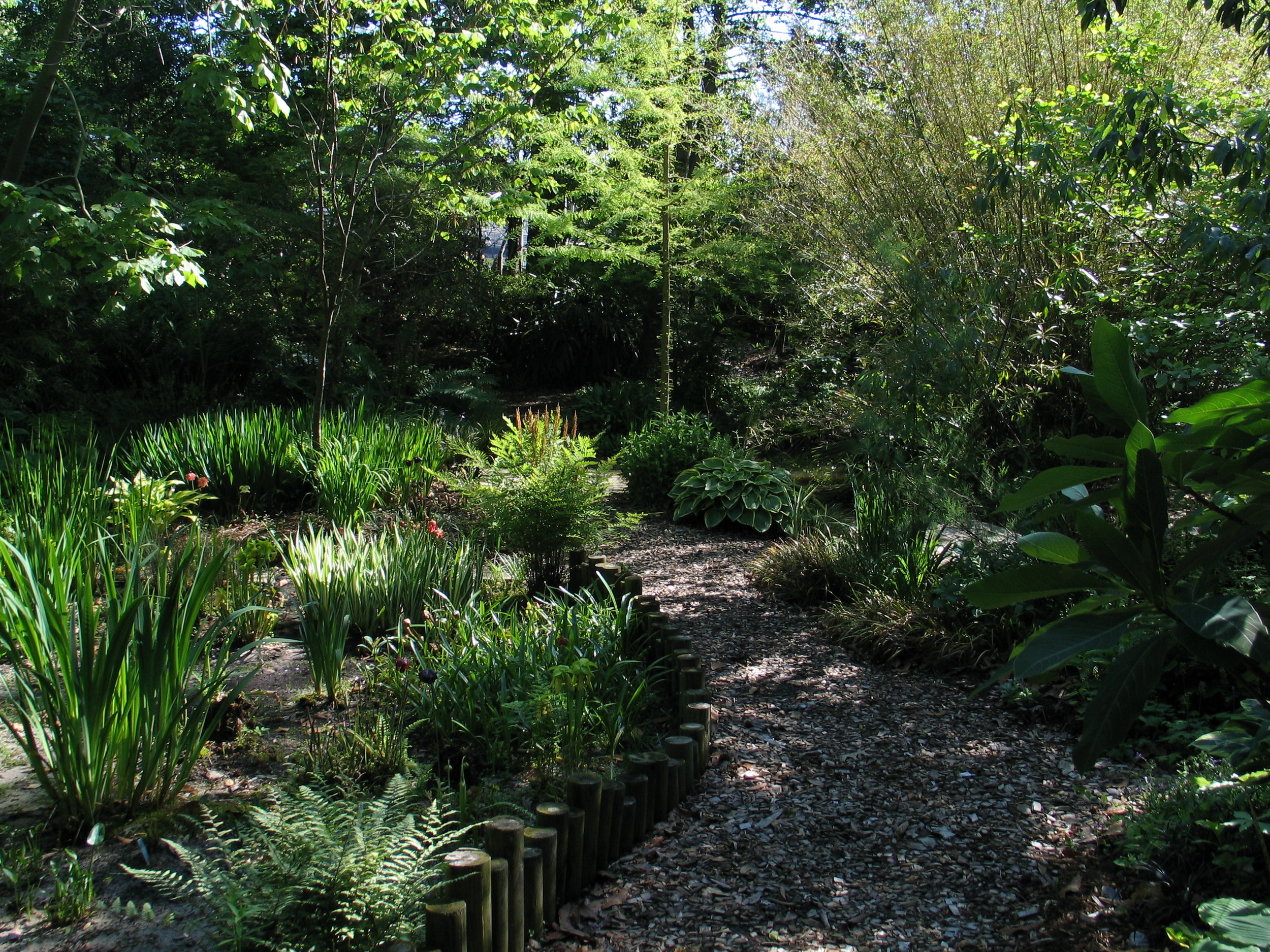 Plant Delights specializes in some very cool stuff, making their own introductions as well as cultivating rare and unusual plants from all over the world (responsibly, too!). They've got the most Zephyranthes cultivars I've ever seen in one place (and mine are doing well, I've had them a few years now). I don't personally grow Hosta, but check out one part of their Hosta seed trials below:
Plant Delights specializes in some very cool stuff, making their own introductions as well as cultivating rare and unusual plants from all over the world (responsibly, too!). They've got the most Zephyranthes cultivars I've ever seen in one place (and mine are doing well, I've had them a few years now). I don't personally grow Hosta, but check out one part of their Hosta seed trials below: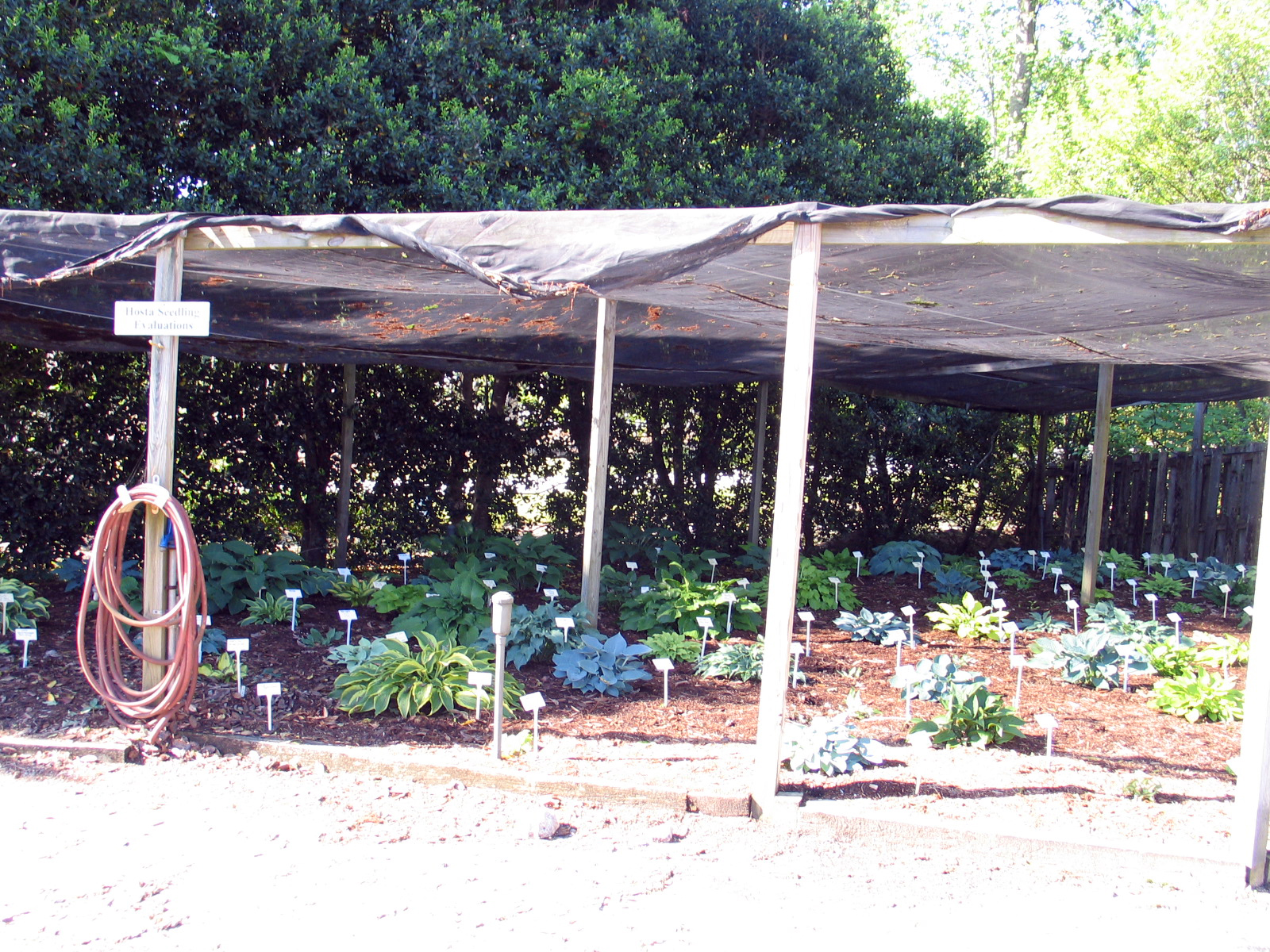 The people there know about their plants and soils, and they sure as heck care. I overheard an impromptu lecture on soils and the evils of commercial fertilizer (organic is the way to go, no matter what you read anywhere else), and I learned that even they get their soils tested annually. They take good care of everything, and to get plants of this quality from people of this quality....well....I have no need to go to Home Depot anytime soon.
The people there know about their plants and soils, and they sure as heck care. I overheard an impromptu lecture on soils and the evils of commercial fertilizer (organic is the way to go, no matter what you read anywhere else), and I learned that even they get their soils tested annually. They take good care of everything, and to get plants of this quality from people of this quality....well....I have no need to go to Home Depot anytime soon.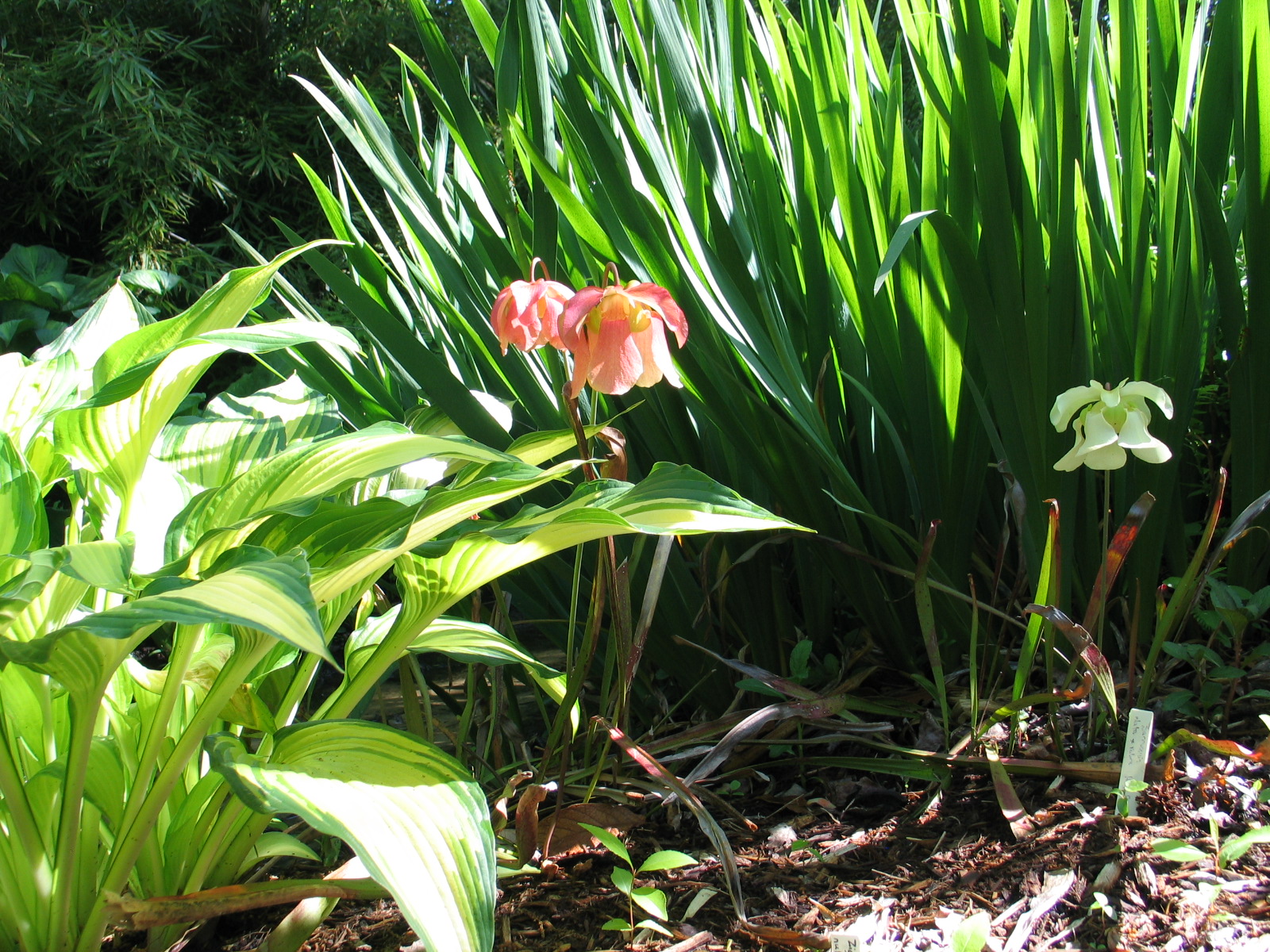
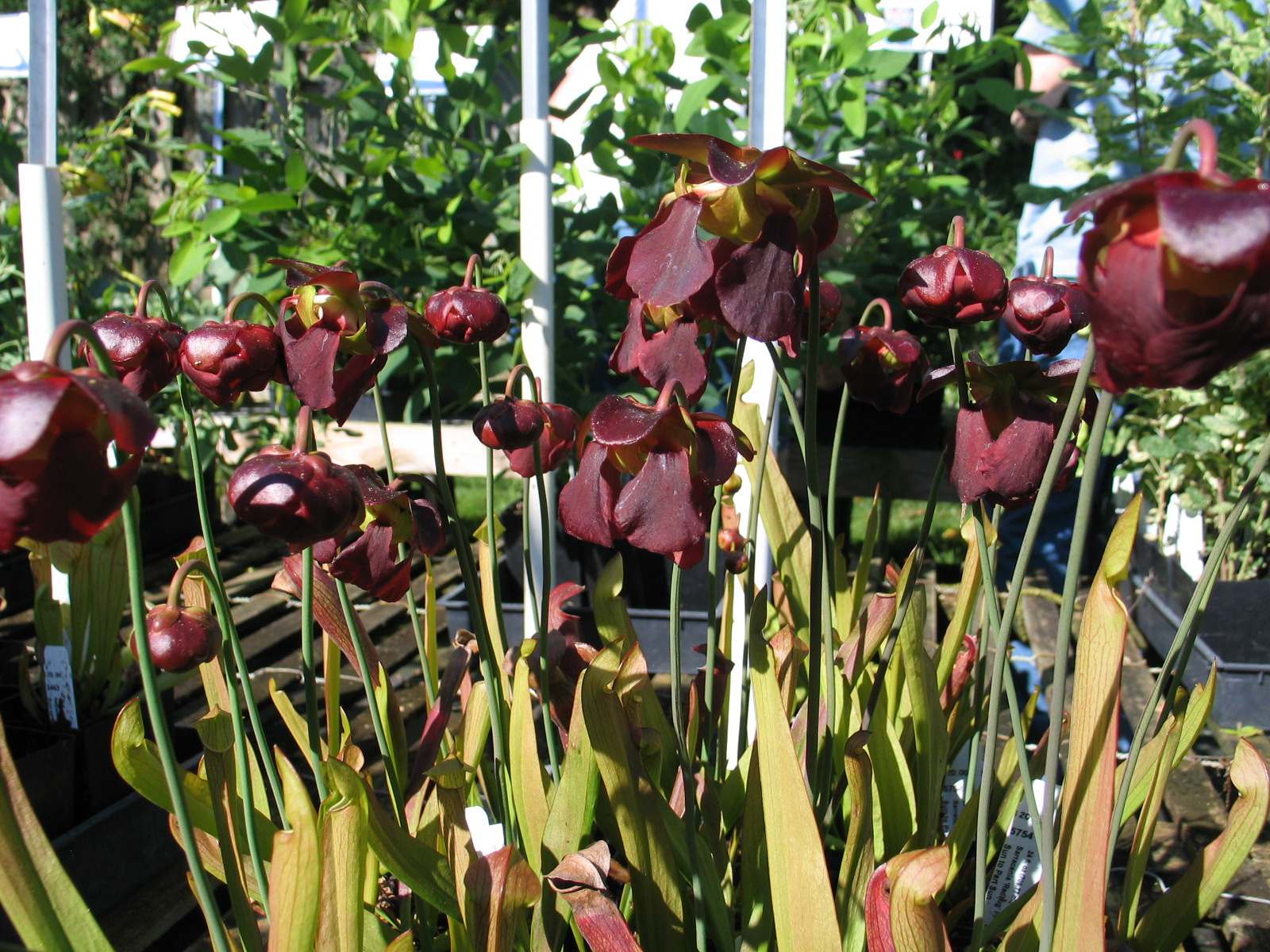 Maybe someday I will try Pitcher plants again....I love how they look in bloom and with other plants (above).
Maybe someday I will try Pitcher plants again....I love how they look in bloom and with other plants (above).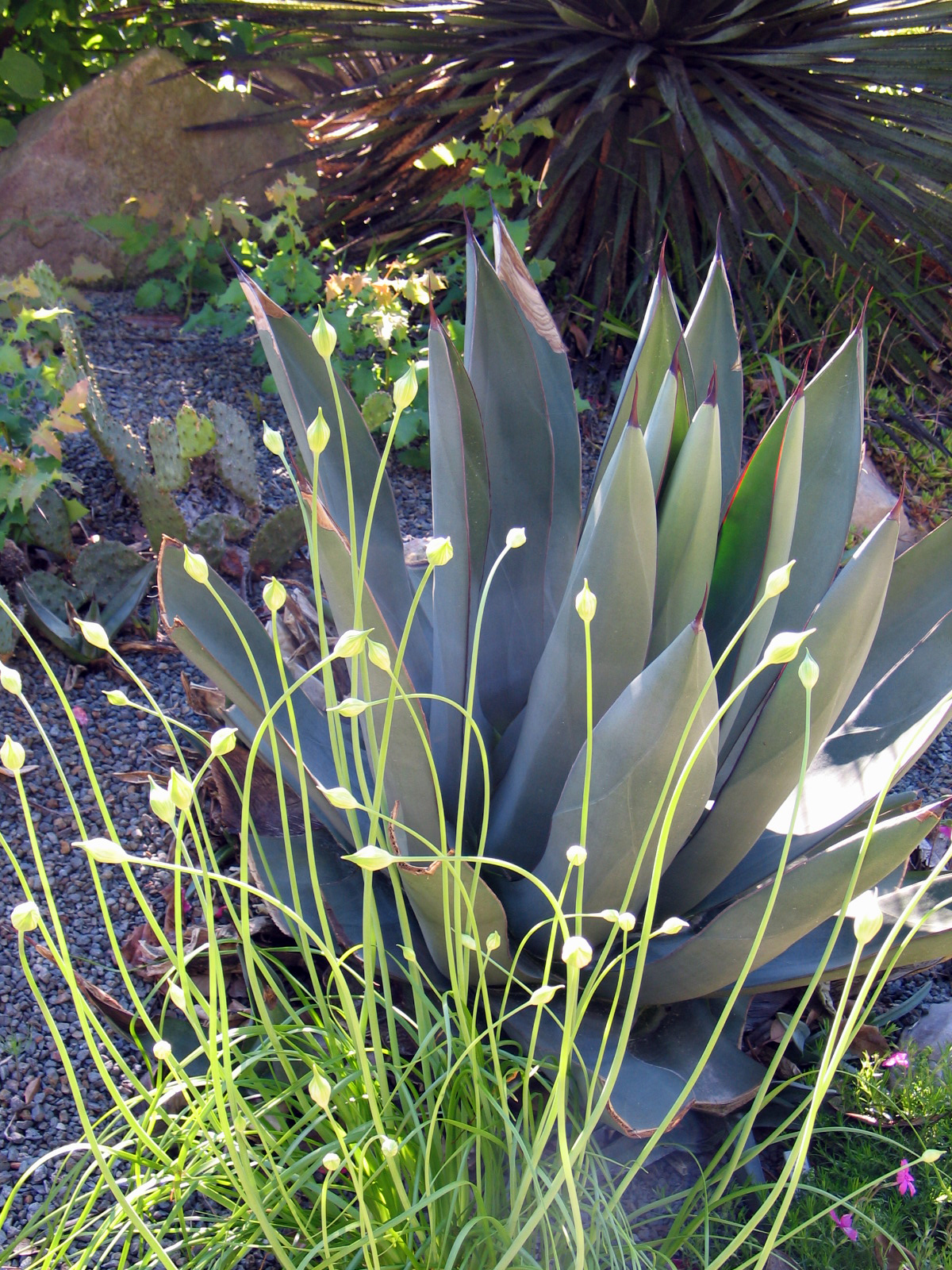
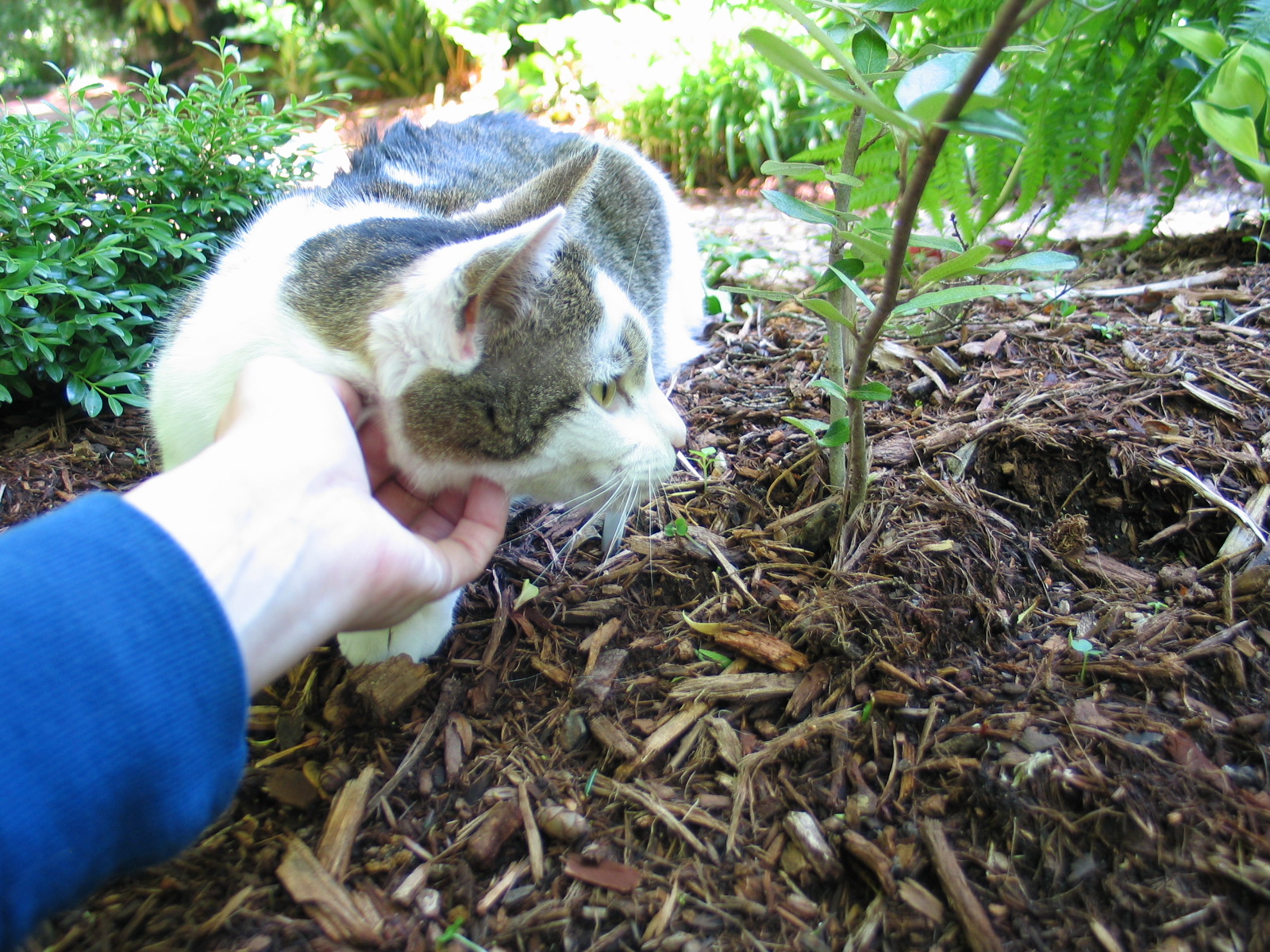 Thank you, Plant Delights Nursery!OH - and what did I carry home in my carry-on bag? Bletilla striata 'Murasaki Skikibu', Arisaema costatum, and Lycoris x 'Elsiae'.
Thank you, Plant Delights Nursery!OH - and what did I carry home in my carry-on bag? Bletilla striata 'Murasaki Skikibu', Arisaema costatum, and Lycoris x 'Elsiae'.
Inspiration Insanity
A good friend recently sent me a link to Pinterest.com. I had to wonder if I really needed yet another online account, another place to find or keep inspirational images and links. I'm already swimming in images and ideas, oodles of mental jumping-off points......I mean, really:- Digital images on my computer (tens of thousands of images)- Binders stuffed full of clipped images from magazines (an entire bookshelf)- Flat file with posters, more clippings, and materials (full, I could use another)- Filing cabinets with articles (four cabinets....at least some of it is bills)- Online: Flickr, iGoogle, Delicious ... (let's not even go there)- Bulletin boards with stuff tacked on (not to mention the fridge)- boxes of paint color fans, fabrics, stone samples....- and never mind the magazines and books....But, after spending a couple of hours (admittedly about four) on the site this morning and saving a few dozen photos, I gave-in and e-mailed them for an invitation to join. Its not like I don't appreciate more (and more and more) inspiration.....but escaping the computer long enough to eat breakfast would be good, too.
Its not like I don't appreciate more (and more and more) inspiration.....but escaping the computer long enough to eat breakfast would be good, too.
"Low Maintenance" - an utterly useless buzzword
I have come to loathe the term "low maintenance". It is essentially meaningless. I am starting to wonder if when a client requests a "low maintenance" design, what they're really saying is that they don't want to do any work themselves, including taking the trouble to find a decent gardener or asking questions.It is imperative for both the client and the designer to discuss exactly what types of gardening activities may occur before doing any design work. Be honest! REALLY! For example, when I got my hair cut last week, I told the stylist that I wash and comb my hair, nothing more. I would not promise to use any appliances or products, and she gave me a cut that works well for my specific needs.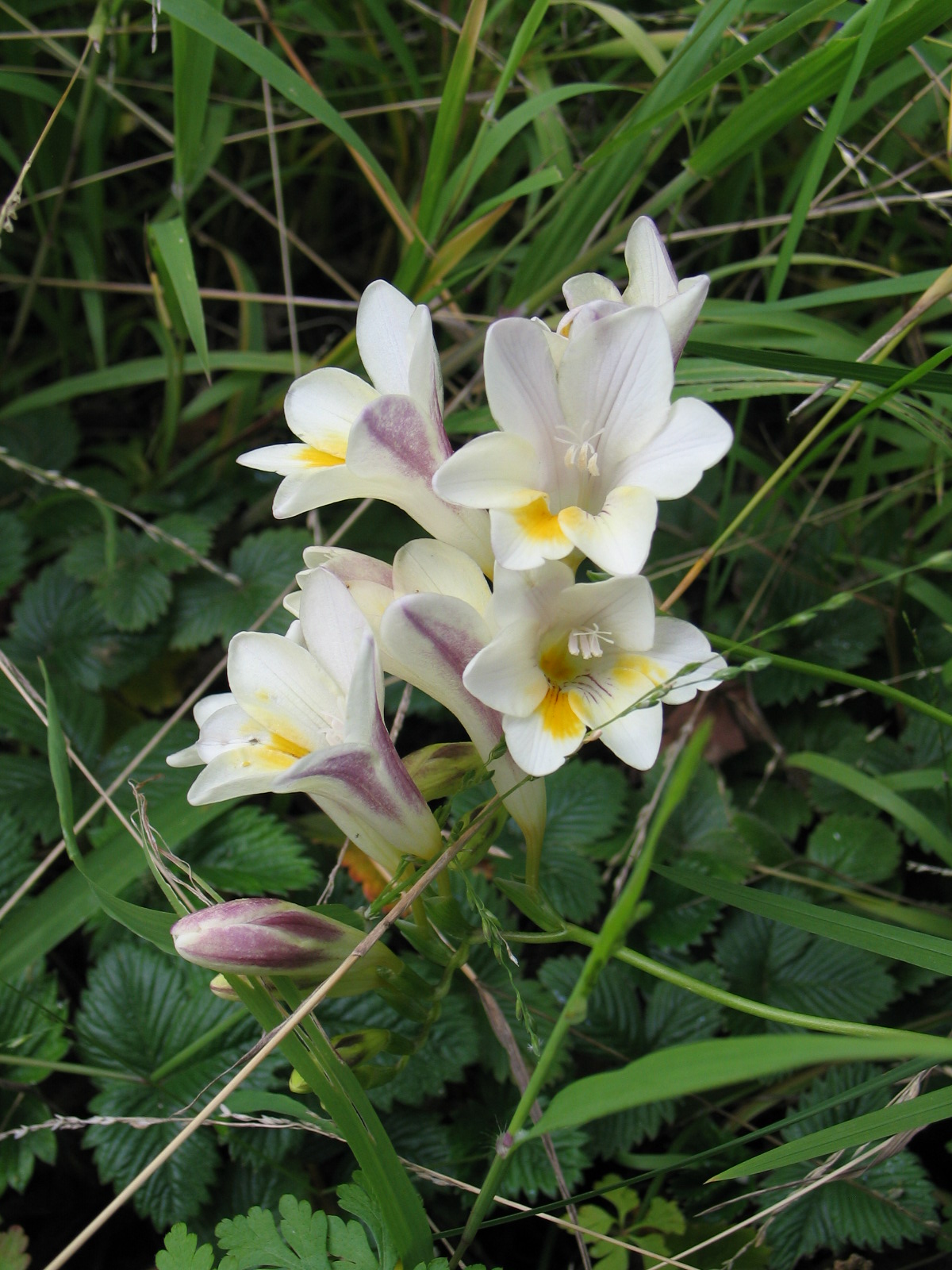 You can see from the above photo (taken on my patio earlier this month) that thanks to my personal distaste for weeding, I have a number of (un-planned) plants just growing together, willy-nilly, doing their thing. I am okay with that, so this is the design solution that my personal garden employs. I'll let nearly anything grow as long as it is healthy and doesn't produce anything painful (thorns, burrs, stingers). This works for me because I live in an apartment and I know that if/when I move, the whole thing will be ripped up - there's not much to be gained by fretting over weeds. Given a different situation, my personal garden might look quite different or it might not.I also grow several roses and a few shrubs - some in containers, some not. I grow dozens of rare bulbs, more than dozens of perennials, and a few orchids, but I don't do much "work". Every year I reliably cut Roses, Freesias, and Sweet Peas for indoor bouquets. I know that rose flowers develop at the very end of a branch and that each cut to remove a flower is, in fact, a pruning cut (and where to take that cut). I also know that my Sweet Peas will bloom nearly forever as long as I keep cutting the flowers off - it is just terrible having an apartment full of sweet pea flowers, just awful...
You can see from the above photo (taken on my patio earlier this month) that thanks to my personal distaste for weeding, I have a number of (un-planned) plants just growing together, willy-nilly, doing their thing. I am okay with that, so this is the design solution that my personal garden employs. I'll let nearly anything grow as long as it is healthy and doesn't produce anything painful (thorns, burrs, stingers). This works for me because I live in an apartment and I know that if/when I move, the whole thing will be ripped up - there's not much to be gained by fretting over weeds. Given a different situation, my personal garden might look quite different or it might not.I also grow several roses and a few shrubs - some in containers, some not. I grow dozens of rare bulbs, more than dozens of perennials, and a few orchids, but I don't do much "work". Every year I reliably cut Roses, Freesias, and Sweet Peas for indoor bouquets. I know that rose flowers develop at the very end of a branch and that each cut to remove a flower is, in fact, a pruning cut (and where to take that cut). I also know that my Sweet Peas will bloom nearly forever as long as I keep cutting the flowers off - it is just terrible having an apartment full of sweet pea flowers, just awful...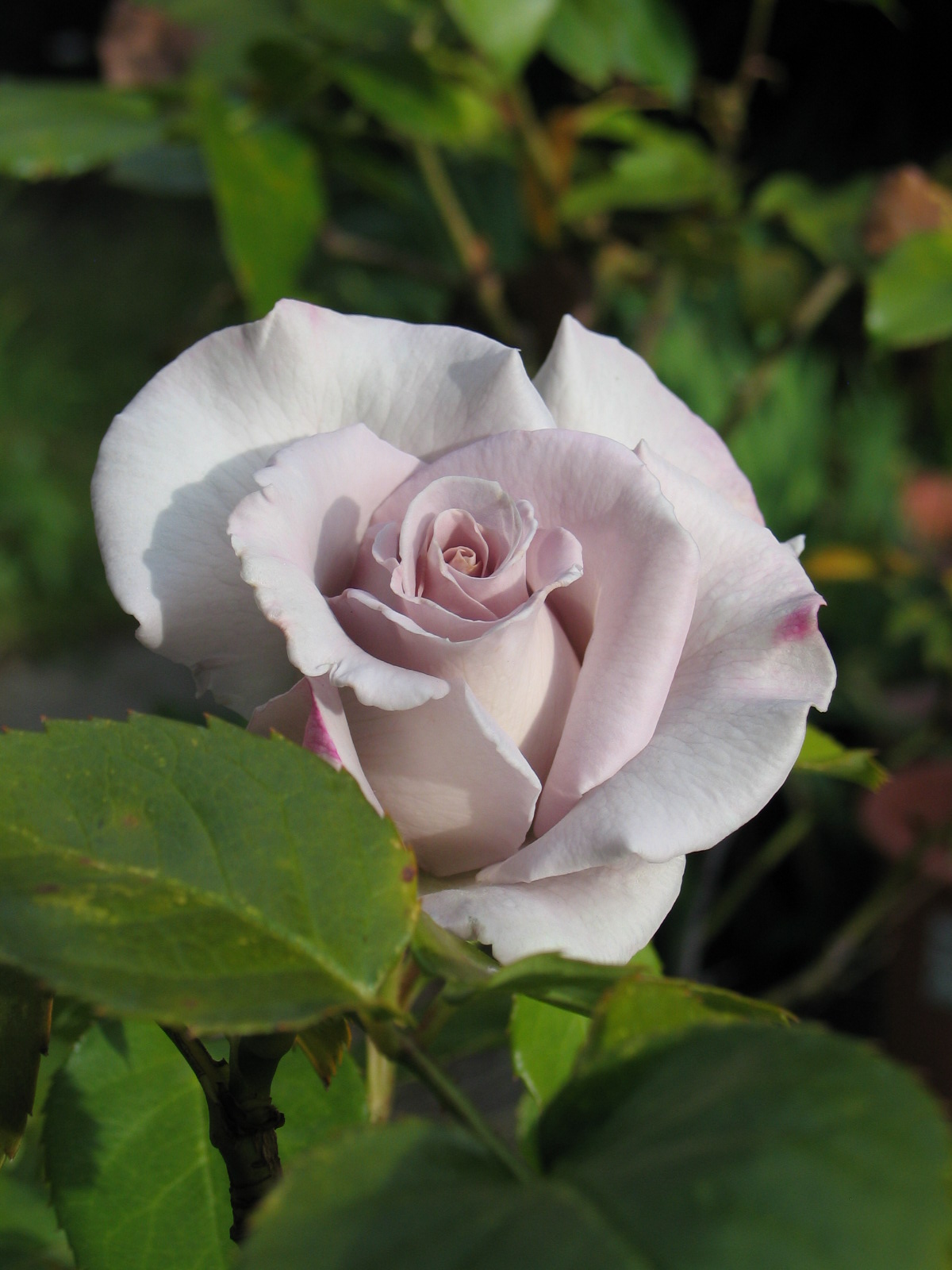 There are countless ways to design a garden so that it doesn't feel like a ton of unwanted work, and so that taking care of it is at least somewhat enjoyable. Getting it to that point is as good a reason as any to work with a design professional and/or do a bit of research for your own garden design solutions....but please don't call cutting flowers "maintenance", that just takes out all the fun.
There are countless ways to design a garden so that it doesn't feel like a ton of unwanted work, and so that taking care of it is at least somewhat enjoyable. Getting it to that point is as good a reason as any to work with a design professional and/or do a bit of research for your own garden design solutions....but please don't call cutting flowers "maintenance", that just takes out all the fun.
My Client's Plants, pt. 2
In plant materials, sometimes you really do get what you pay for.The Hellebores' stay here is nearly at an end. I have enjoyed having these little beauties here since the day I posted about their arrival just over 3 months ago in November 2010. Since they arrived, they've done nothing but amaze me. Their quality is outstanding, far superior than what was available locally. These green friends illustrated beautifully that sometimes it is well worth it to pay more for something that on the surface seems like the same thing.You see, the same week that I received that box of beauties from Fraser's Thimble Farms, I got a little green myself and drove over to a well regarded retail nursery in the East Bay. I paid $20. for a single 1 gallon plant of the exact same cultivar. My client's plants cost $39. each, not counting shipping and inspection certificates (so actually, they cost quite a bit more than that). I potted them on arrival because they had been bare-rooted for the trip, and soon they'll be installed in their new home's garden. In the photo below, that scrappy little guy in the front is mine.
Since they arrived, they've done nothing but amaze me. Their quality is outstanding, far superior than what was available locally. These green friends illustrated beautifully that sometimes it is well worth it to pay more for something that on the surface seems like the same thing.You see, the same week that I received that box of beauties from Fraser's Thimble Farms, I got a little green myself and drove over to a well regarded retail nursery in the East Bay. I paid $20. for a single 1 gallon plant of the exact same cultivar. My client's plants cost $39. each, not counting shipping and inspection certificates (so actually, they cost quite a bit more than that). I potted them on arrival because they had been bare-rooted for the trip, and soon they'll be installed in their new home's garden. In the photo below, that scrappy little guy in the front is mine.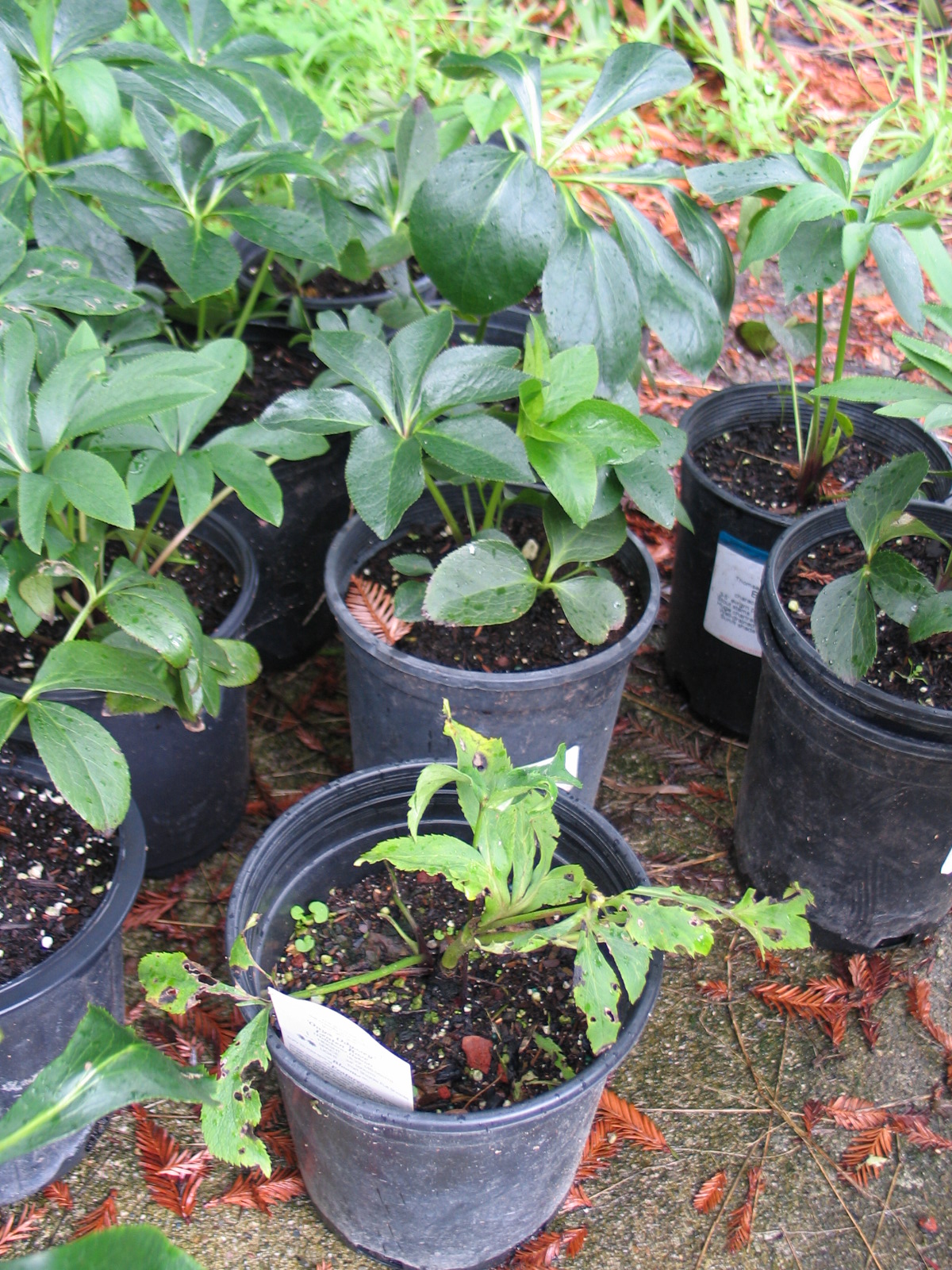 Unfortunately, my plant looks exactly as it did the day I got it, where my client's plants are considerably nicer. The ones from Fraser's are known to be about 4 years old. In conversations with their staff, I learned that Hellebores need to be a few years old before they are mature enough to bloom, so perhaps this is the problem with my little one....OR perhaps the difference is that mine was grown without personal attention at a commercial grower where the ones from Fraser's were grown with care by a knowledgeable bunch of people. Either way, it was well worth the extra money for quality plant materials.
Unfortunately, my plant looks exactly as it did the day I got it, where my client's plants are considerably nicer. The ones from Fraser's are known to be about 4 years old. In conversations with their staff, I learned that Hellebores need to be a few years old before they are mature enough to bloom, so perhaps this is the problem with my little one....OR perhaps the difference is that mine was grown without personal attention at a commercial grower where the ones from Fraser's were grown with care by a knowledgeable bunch of people. Either way, it was well worth the extra money for quality plant materials. I'm looking forward to seeing if mine grows into a nice specimen now that I'm in charge, and to seeing how well the ones going to my clients' garden will perform over time under the care of his gardener. I will be very interested to watch them all, even though I'm sad to see these beauties leave my patio.
I'm looking forward to seeing if mine grows into a nice specimen now that I'm in charge, and to seeing how well the ones going to my clients' garden will perform over time under the care of his gardener. I will be very interested to watch them all, even though I'm sad to see these beauties leave my patio.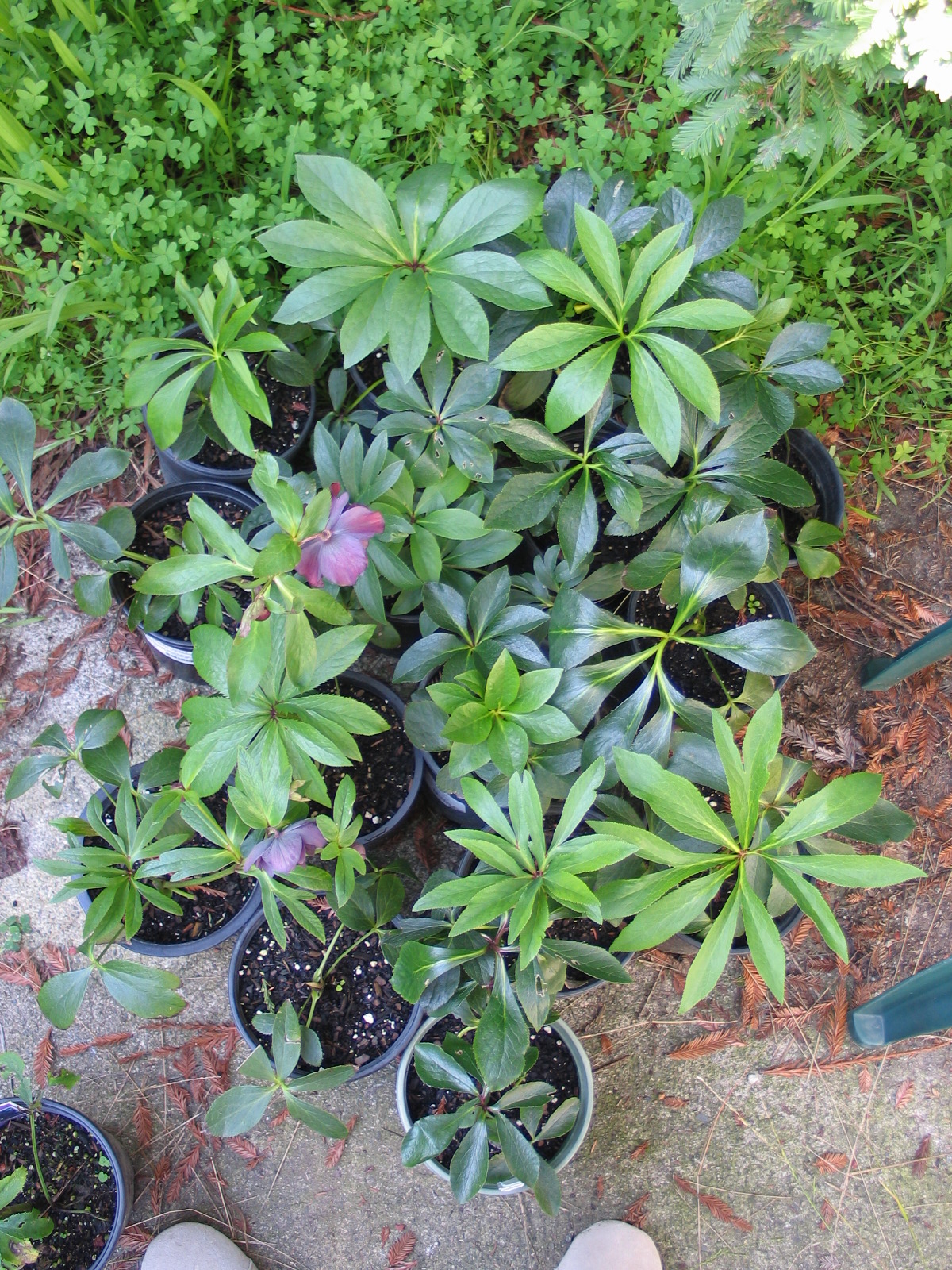
Associations
I read Studio G's blog often, it is a wonderful source of entertainment for me. I recently stumbled across this post, clicking on it because of the title "Religion & Garden Design". Read it.Reading that gave me the nudge I needed to finally mention associations here, they are powerful and invisible aspects of design work that must never be ignored. The better designers understand that they must get to know their clients so that subtle, personal conflicts of negative associations can be avoided and positive associations used for inspiration. Consider the meaning in shapes, colors, plants, orientation (East/West), and views.For example: when I see Beautyberry (the plant image in Studio G's post) I remember the Dallas Arboretum, visiting my friend Melinda, and working at a wonderful Dallas Landscape Architecture firm with wonderful people.The smell of Tomatoes reminds me of my childhood in Southern California, as does for Australian Tree Fern, Mother Fern, Amaryllis belladonna, Agapanthus, and Tuberous Begonias (especially the orange ones).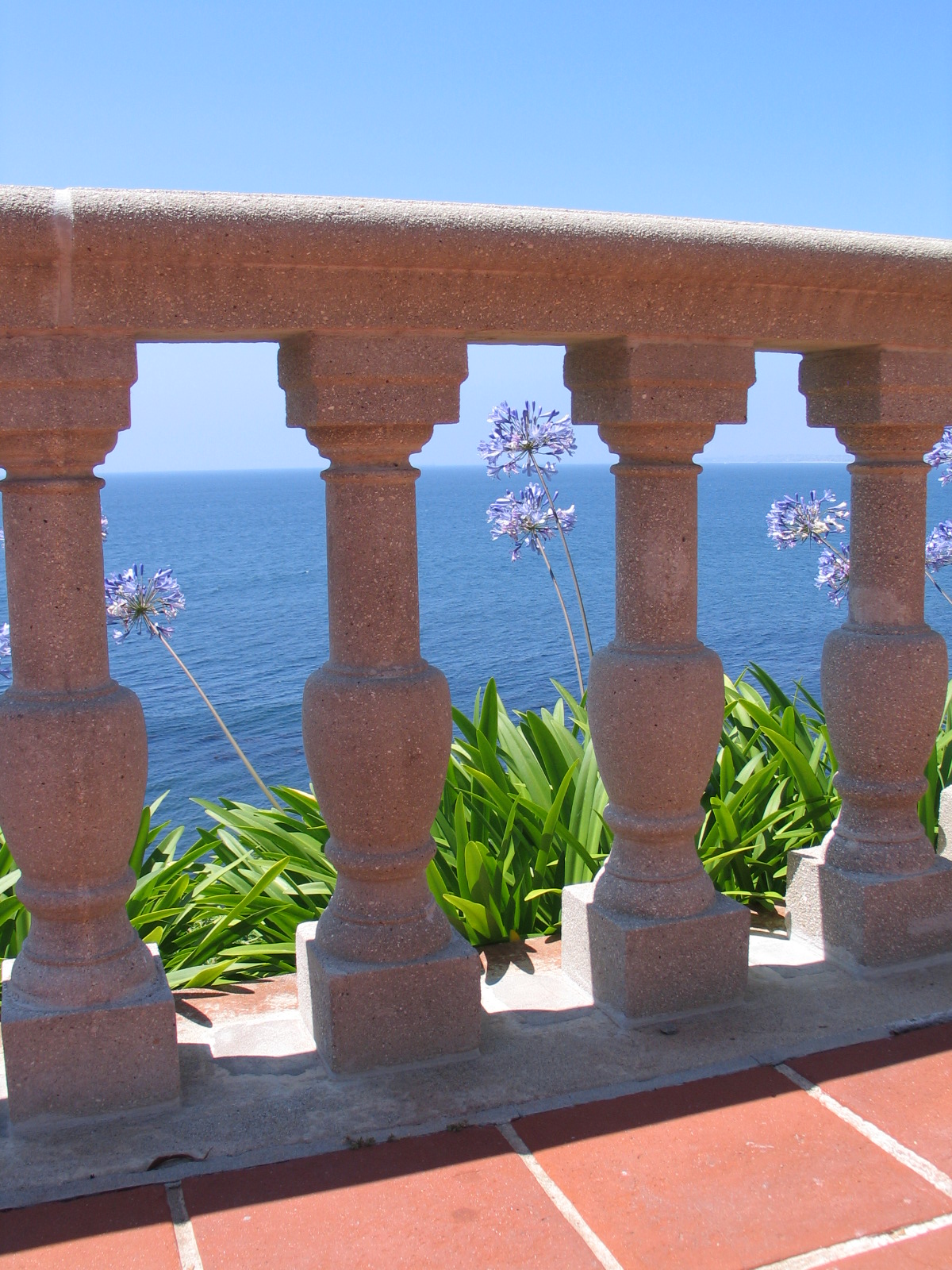 Red and yellow together remind me of Mc Donalds, which I don't think very highly of....I've seen Topher Delaney speak about her landscape work a couple of times, I also met her once at a lunch. At the beginning of a project, she asks her clients to tell her about where they lived when they were little. They have a conversation and get to know each other. She uses this more personal understanding in her design work and succeeds in bringing more meaning to the work than most.So - who are you designing for? ....and how will the design meet their needs, bring meaning, or make it beautiful for the eye of the beholder?
Red and yellow together remind me of Mc Donalds, which I don't think very highly of....I've seen Topher Delaney speak about her landscape work a couple of times, I also met her once at a lunch. At the beginning of a project, she asks her clients to tell her about where they lived when they were little. They have a conversation and get to know each other. She uses this more personal understanding in her design work and succeeds in bringing more meaning to the work than most.So - who are you designing for? ....and how will the design meet their needs, bring meaning, or make it beautiful for the eye of the beholder?
Container Garden Inspiration
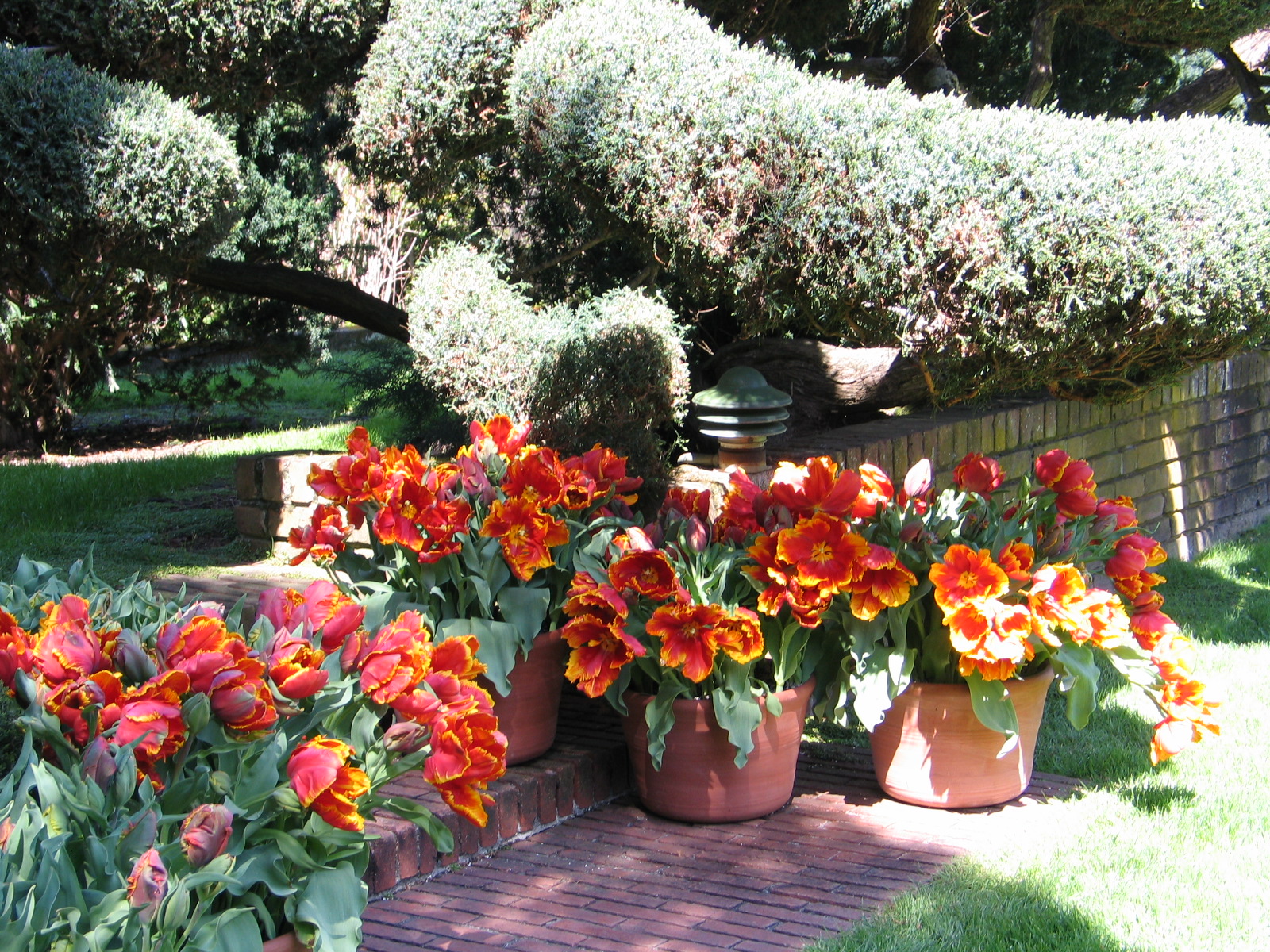 I love container gardening! Love it. I garden both in the ground and in containers at home, I can't keep from filling pretty much everything with soil and something growing.
I love container gardening! Love it. I garden both in the ground and in containers at home, I can't keep from filling pretty much everything with soil and something growing.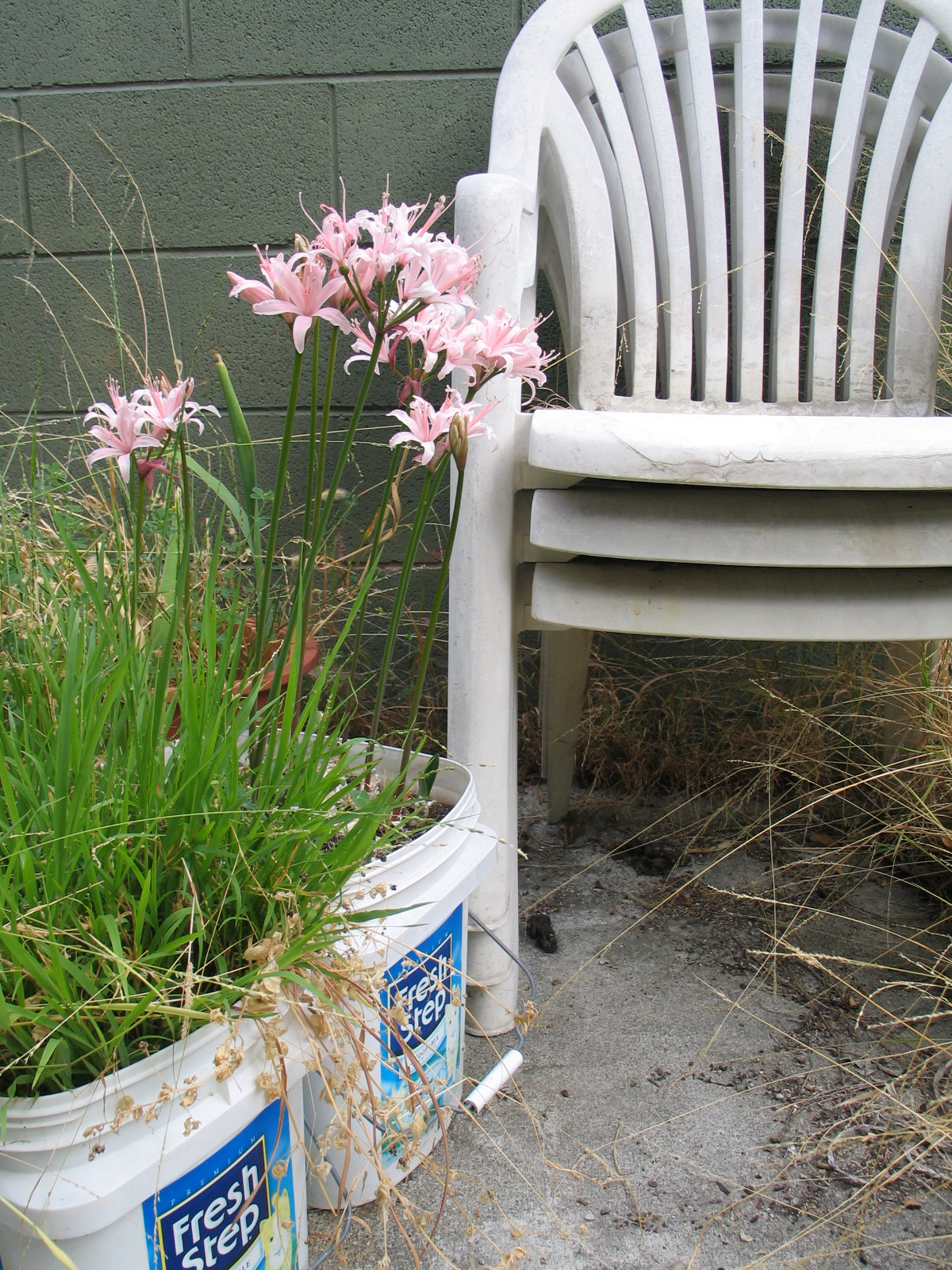
I wanted to post this because not every pot looks good with every plant, some look truly wonderful together, and some just awful. I design for clients very differently than I treat my own container garden. I choose containers for clients that go with the architecture, the plants, and so forth.
In my own garden, however, the containers can be almost anything - kitty litter buckets with holes drilled in the bottom, nursery liners, and a random assortment of impulse purchases and gifts. 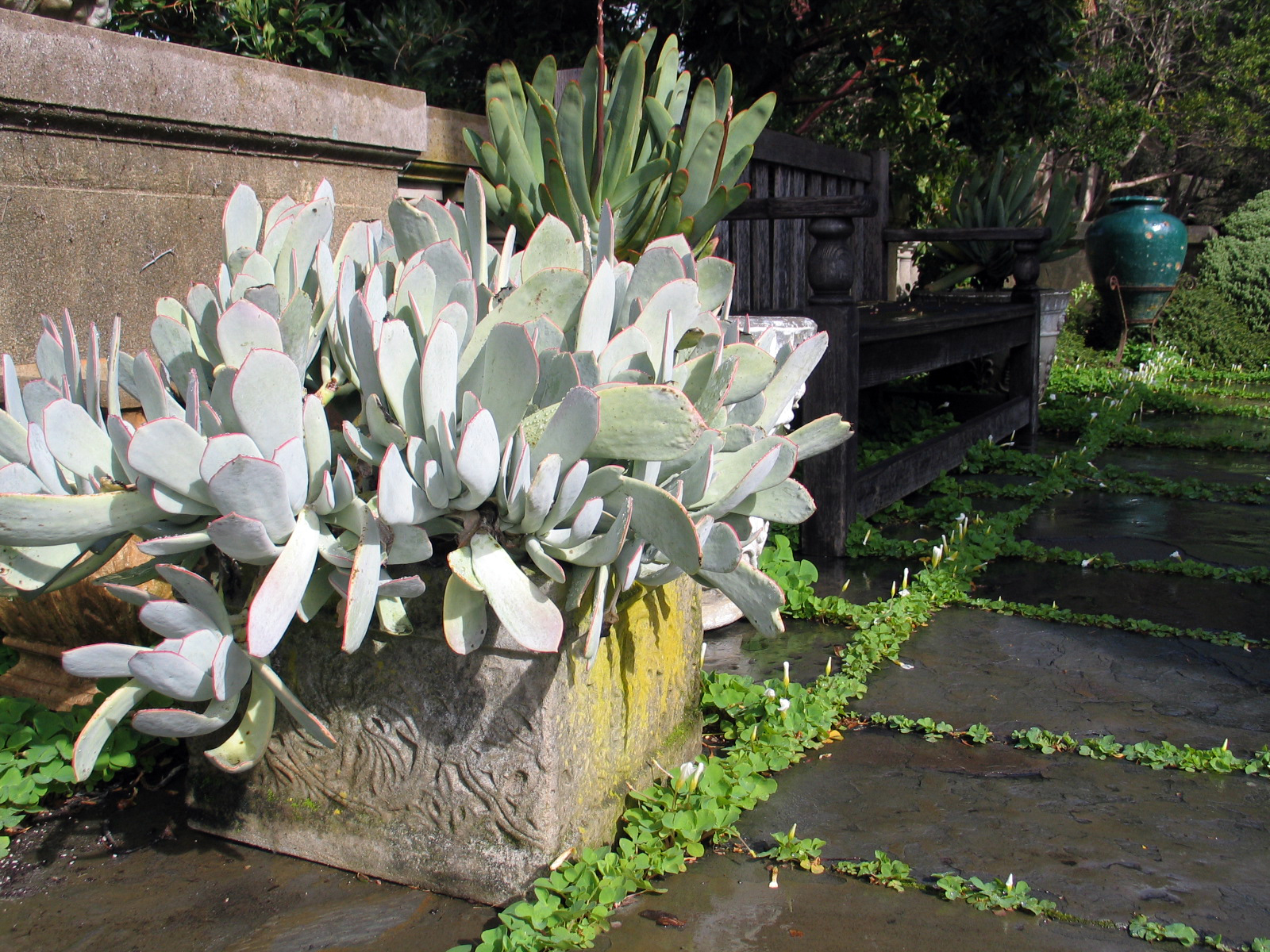
I think that the most important thing when putting together a container garden is deciding what you are showcasing; the plant or the pot?
Which plant looks good in a particular pot can be surprising. I have found that it is important to see them together if the purchase is an important one. If you're like me, and buy plants and pots on impulse, don't sweat it. But, if the container and the plant will be important focal pieces of your design, then it is worth it to take either the pot (or a small sample with the same finish) or the plants that will be used (at least a bouquet of the leaves and a good imagination) around with you when shopping.
Why Client Questionnaires Suck, pt. 2
Modative blog post: I receive updates on this architecture firm's blog when they add a new post, and I thought it was interesting when they recently posted about their client questionnaire, so I thought I would share it (please notice that to their credit, they ASK these questions in person). I like their blog and that they are sharing their processes so openly.I still think written questionnaires are a bad idea. I think it is far more important to encourage an open dialog and be responsive to the dynamics of the design process than anything else (some of those answers could change). Also note that only the last question, number 10, opens the door to 'getting to know' the client. Some clients aren't very open, others may give too much information, and they don't always like ideas presented.My first post on client questionnaires gets more traffic than anything else I've written here. I suspect that there are a lot of aspiring designers out there looking for examples of the best questionnaires. I did this, too, early in my career. I've even got a few oldies saved on the computer, but I don't use them.Unlike designing for a public, institutional, or commercial facility, when designing for people's homes, the Owners need to work with someone that they can trust above all else. Someone who will listen and ask questions, then interpret the answers and produce a solution that the client will like (preferably LOVE).Designing for others isn't like any other relationship. The designer needs to get inside the client's head a little, ask some personal questions (about money, lifestyle, privacy concerns, aesthetic preferences). Whether you're designing an interior, structure, or garden, this is an involved and personal process.All clients need to know that you are a professional, but they also need to feel that you care about them and their project. They need to believe that you will treat their investment responsibly, keep private information private, and deliver something beyond their dreams. Developing a relationship that advances the open communication needed is one of the most important skills that a designer can have.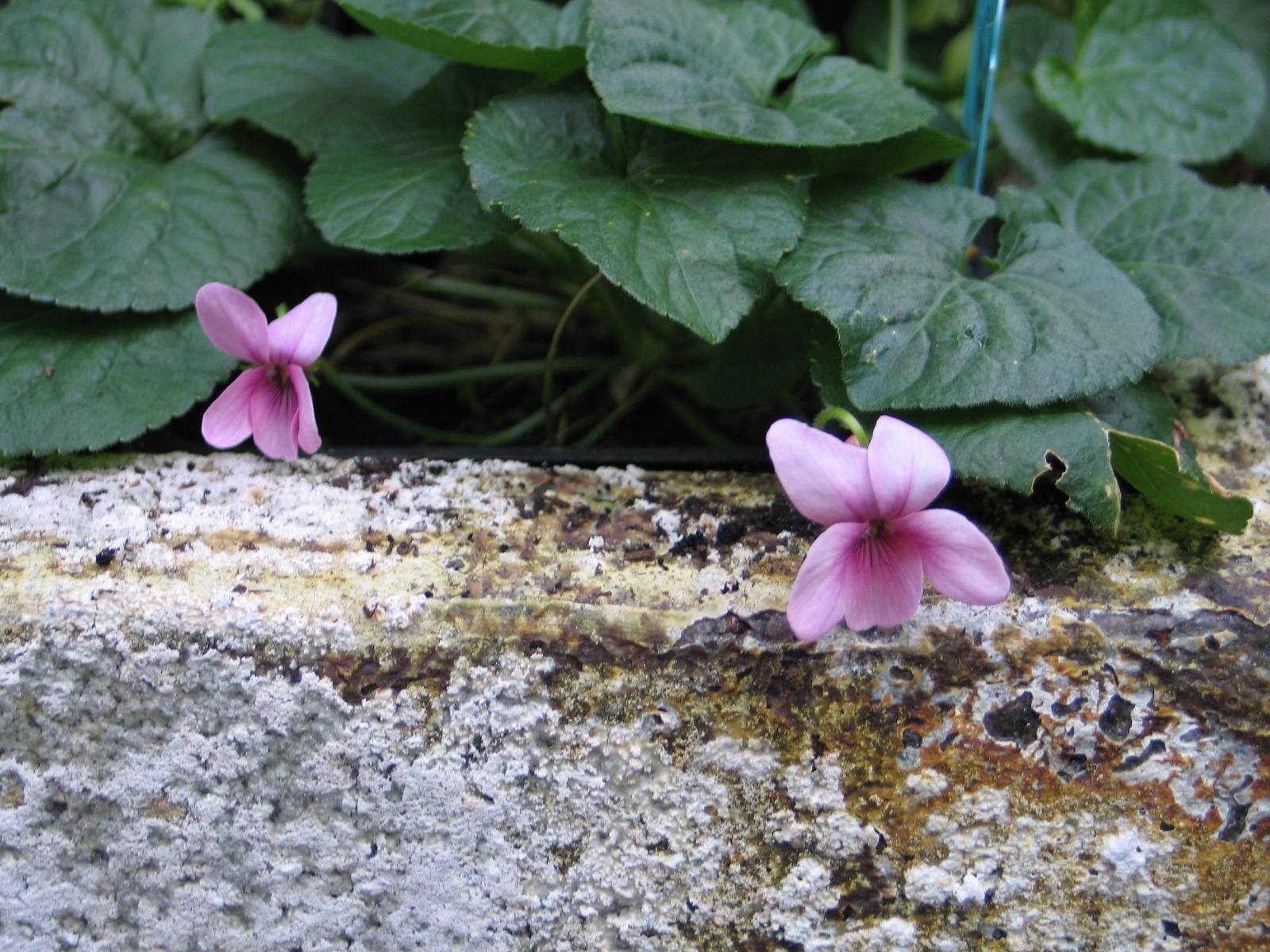 Here's a story from my experience: I once worked for a small design/build firm for a short time. I advanced the design development phase of a large and historically significant home. The Owners were out of town a lot, so it took a while to schedule a meeting, but the company had been working on the project for a while already. I read the correspondence and found the company's client questionnaire. The only notes I found regarding aesthetics were written by the client on the (mailed) questionnaire. They noted that they did not like the color orange or Roses. Okay then - I designed around what would be appropriate for the stately old home, avoiding orange flowers, orange foliage, and Roses. We finally met, and they brought images with them of things that they liked. After some discussion, it became clear that the only images they responded to favorably included chartreuse foliage and white flowers. In fact, they requested that we include shrub roses!!
Here's a story from my experience: I once worked for a small design/build firm for a short time. I advanced the design development phase of a large and historically significant home. The Owners were out of town a lot, so it took a while to schedule a meeting, but the company had been working on the project for a while already. I read the correspondence and found the company's client questionnaire. The only notes I found regarding aesthetics were written by the client on the (mailed) questionnaire. They noted that they did not like the color orange or Roses. Okay then - I designed around what would be appropriate for the stately old home, avoiding orange flowers, orange foliage, and Roses. We finally met, and they brought images with them of things that they liked. After some discussion, it became clear that the only images they responded to favorably included chartreuse foliage and white flowers. In fact, they requested that we include shrub roses!!
My Client's Plants
I am working on the design of a garden in San Francisco and was pleasantly surprised today by the delivery of the Hellebores that were ordered from Canada. While I was potting them for protection during their wait to be installed at the site, it occurred to me that this shipment of plants represented some thoughts on customer service and the design/construction processes.Most Landscape Architecture firms would not be able to accept delivery of plants for a client and care for those plants until they could be installed. They might rely instead on either using only the plants that are seasonally available or contract growing (with someone else) to care for those plants that must be received before the site is ready. There are issues of liability (what if they die?!), space, and materials for the task. What results can be either a prohibitively complicated and expensive ordeal, a garden that is skewed to one particular season, or having to ask the client to be patient and wait while plants become available in the future (not always acceptable by some clients). 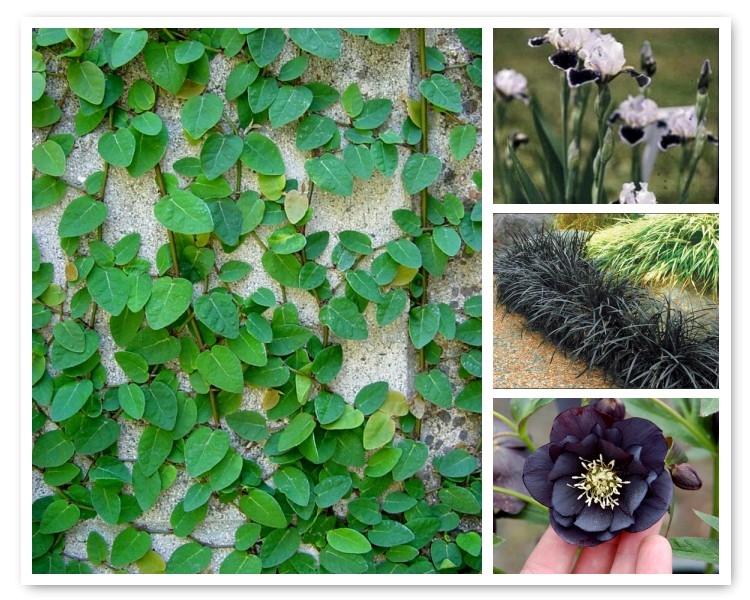 Included in this particular project there will be a discrete courtyard featuring a statue. We are using four different plants; Ficus pumila (Creeping Fig), Ophiopogon nigrescens (Black Mondograss), Helleborous 'Onyx Odyssea' (a double black flowering Lenten Rose), and Iris 'Frosted Velvet' (a "miniature tall" form Bearded Iris). The Ficus and Ophiopogon are evergreen and will form the main planting to show off the sculpture, then the Iris will be in bloom in the Spring with leaves from late Winter through Summer, and the Hellebores will be in bloom in Winter with leaves holding on through Spring. I don't expect to have both Irises and Hellebores flower at the same time, though it is possible that this could occur depending on weather conditions and temperatures (especially in the Bay Area). While the Irises prefer more sun and the Hellebores more shade, the site location and orientation make it possible to use both in the same small area.I presented the palette (above) to the client earlier this month. Before doing presenting, I learned that the Iris were not going to be shipped until next July, and that our local growers who carried the Hellebores had already sold out for the year. I explained to the client that we would be ordering the Iris for delivery nine months in the future and that the Hellebores would need to be ordered immediately from Canada before the grower's shipping season closed. He accepted the planting concept, so I had the plants ordered with delivery to my home. I did this for a couple of reasons:1. I wanted to inspect the plants before anyone else saw them to make sure there were no problems (and I work from home). Having them shipped to my home also meant that I could accept delivery at any time (they arrived today - the Saturday after Thanksgiving) regardless of holidays, weekends, and business hours.2. The plants would be shipped bare root and would need immediate attention by someone who knew what to do and had the time.3. The landscape contractor had not yet been formally retained.4. This also made me feel that I was giving my client the best service I could by personally protecting his investment in them and, by extension, his trust in me.It is my habit to order plants from all over the world. Because of this, I knew ahead of time that both mail order companies were reputable and that the plants would likely be in great shape. I was not disappointed! Fraser's Thimble Farms worked with me to hold the plants until the payment arrived. I took their advice to pay for air priority shipping. The plants also required a Phytosanitary Certificate (they were inspected by the Canadian Food Inspection Agency) before coming into the U.S. The shipment was also opened and inspected by U.S. Customs upon arrival.Below are some photos from this morning's potting:
Included in this particular project there will be a discrete courtyard featuring a statue. We are using four different plants; Ficus pumila (Creeping Fig), Ophiopogon nigrescens (Black Mondograss), Helleborous 'Onyx Odyssea' (a double black flowering Lenten Rose), and Iris 'Frosted Velvet' (a "miniature tall" form Bearded Iris). The Ficus and Ophiopogon are evergreen and will form the main planting to show off the sculpture, then the Iris will be in bloom in the Spring with leaves from late Winter through Summer, and the Hellebores will be in bloom in Winter with leaves holding on through Spring. I don't expect to have both Irises and Hellebores flower at the same time, though it is possible that this could occur depending on weather conditions and temperatures (especially in the Bay Area). While the Irises prefer more sun and the Hellebores more shade, the site location and orientation make it possible to use both in the same small area.I presented the palette (above) to the client earlier this month. Before doing presenting, I learned that the Iris were not going to be shipped until next July, and that our local growers who carried the Hellebores had already sold out for the year. I explained to the client that we would be ordering the Iris for delivery nine months in the future and that the Hellebores would need to be ordered immediately from Canada before the grower's shipping season closed. He accepted the planting concept, so I had the plants ordered with delivery to my home. I did this for a couple of reasons:1. I wanted to inspect the plants before anyone else saw them to make sure there were no problems (and I work from home). Having them shipped to my home also meant that I could accept delivery at any time (they arrived today - the Saturday after Thanksgiving) regardless of holidays, weekends, and business hours.2. The plants would be shipped bare root and would need immediate attention by someone who knew what to do and had the time.3. The landscape contractor had not yet been formally retained.4. This also made me feel that I was giving my client the best service I could by personally protecting his investment in them and, by extension, his trust in me.It is my habit to order plants from all over the world. Because of this, I knew ahead of time that both mail order companies were reputable and that the plants would likely be in great shape. I was not disappointed! Fraser's Thimble Farms worked with me to hold the plants until the payment arrived. I took their advice to pay for air priority shipping. The plants also required a Phytosanitary Certificate (they were inspected by the Canadian Food Inspection Agency) before coming into the U.S. The shipment was also opened and inspected by U.S. Customs upon arrival.Below are some photos from this morning's potting: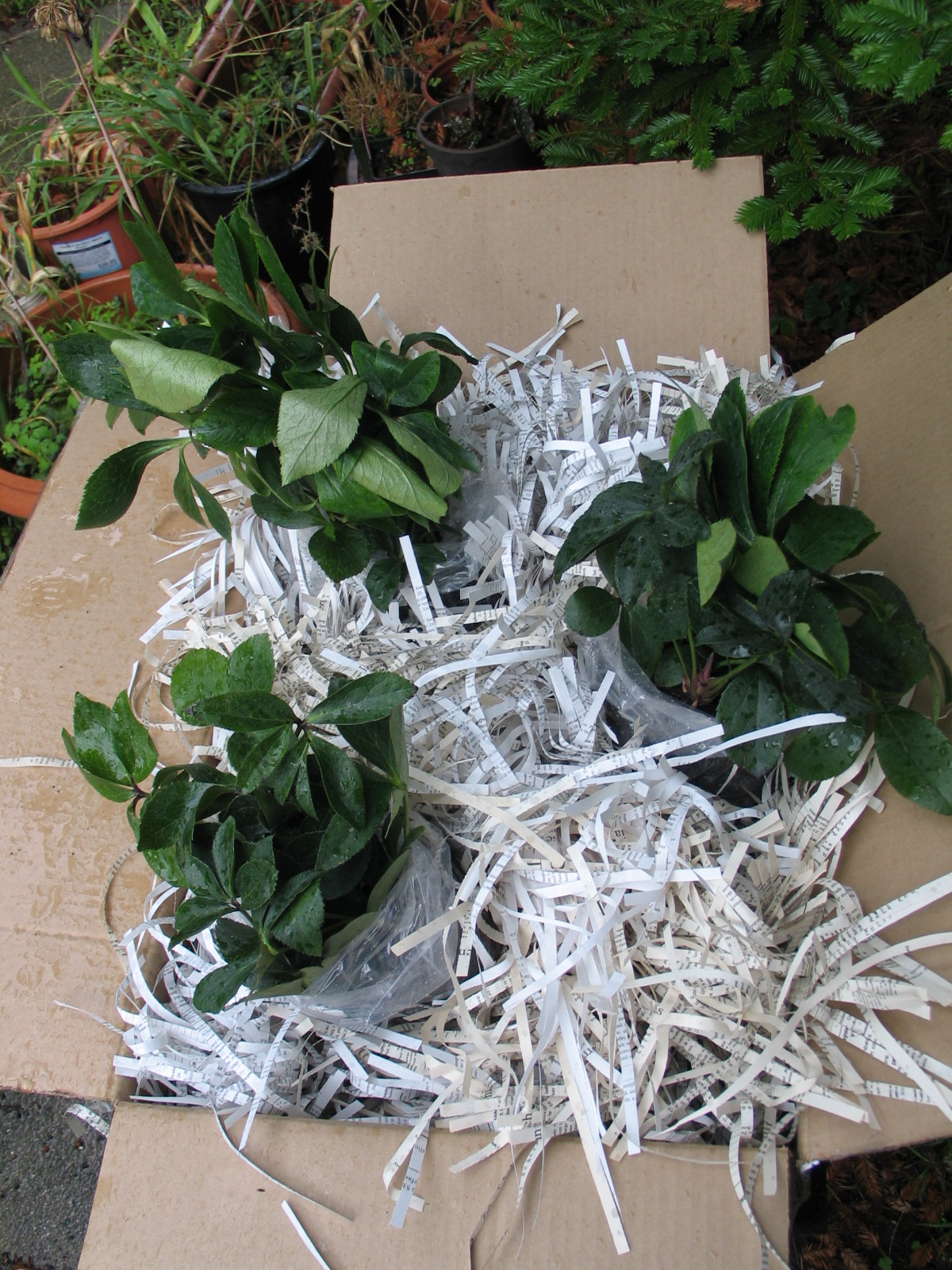
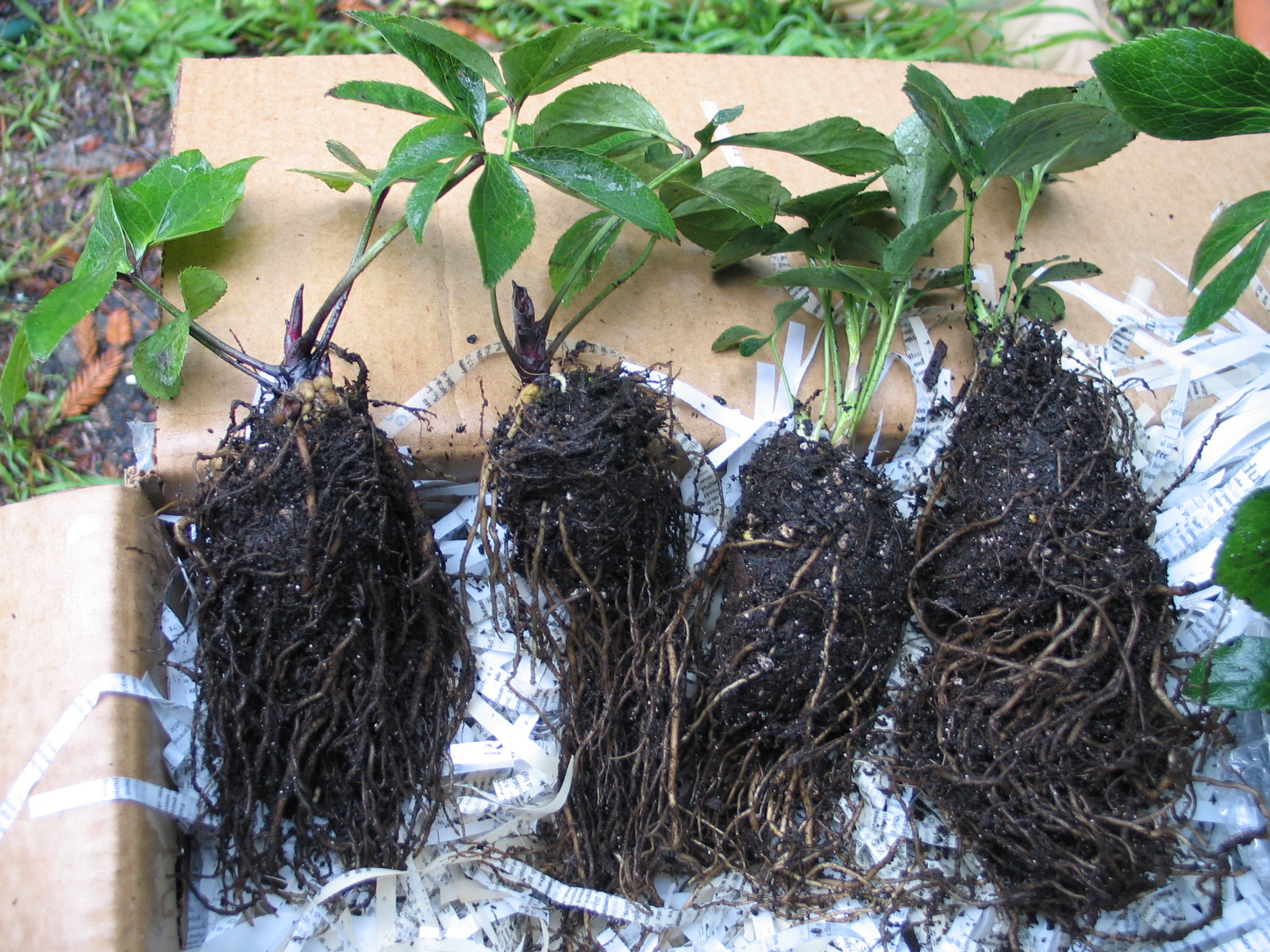
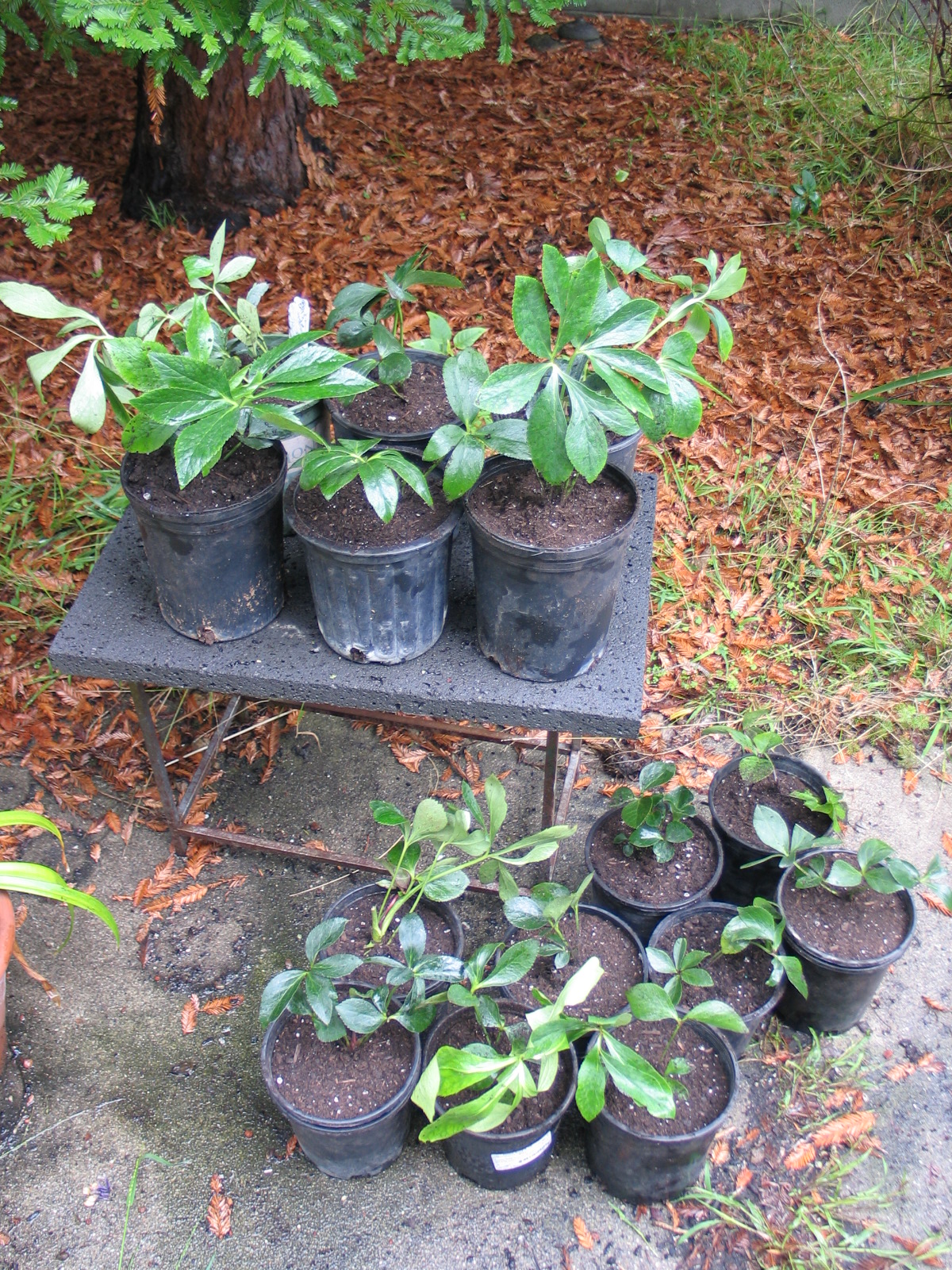 All in all, excellent plants - potted and ready for what comes next. My own Hellebores have not leafed-out yet, so it will be interesting to see how these behave, but they each have new growth on them (see the middle photo). They've been through a lot, being bare-rooted, inspected twice, then finally re-potted (they'll be disturbed again soon when they're planted in their new home).I have been frustrated in the past with the issues that come up when trying to design a garden around the seasonal availability of the plants I want to use. I think it is well worth the extra effort to get the exact plants desired rather than giving up and just finding something else that is less of a pain. I am looking forward to seeing them planted in their new home and will post again....
All in all, excellent plants - potted and ready for what comes next. My own Hellebores have not leafed-out yet, so it will be interesting to see how these behave, but they each have new growth on them (see the middle photo). They've been through a lot, being bare-rooted, inspected twice, then finally re-potted (they'll be disturbed again soon when they're planted in their new home).I have been frustrated in the past with the issues that come up when trying to design a garden around the seasonal availability of the plants I want to use. I think it is well worth the extra effort to get the exact plants desired rather than giving up and just finding something else that is less of a pain. I am looking forward to seeing them planted in their new home and will post again....
"Low Maintenance" Gardens?
It seems that everyone is aware that gardens can require some effort to maintain. Professionals in the landscape design and construction industry understand that the success of any outdoor space depends on thoughtful design, quality installation, and ongoing, intelligent maintenance. Not one of these three items can deliver the desired result without the other two.
Read moreI am honored. Thanks!
My friend and colleague Page Huyette asked me to write a post for her blog as a guest writer. I wrote about editing as part of the design process. Everyone works differently, I think this post illuminates part of my process really well (it should, I wrote it!).Here is the link to that post, and below one of the images (because no blog post should be without pictures!). I took this snapshot one day a few years ago. I had been working for a while and when I "came up for air", I thought that all the stuff on my desk (at Scott Lewis Landscape Architecture) looked interesting together. I'm glad I took the picture, I had no idea it would come in handy some day.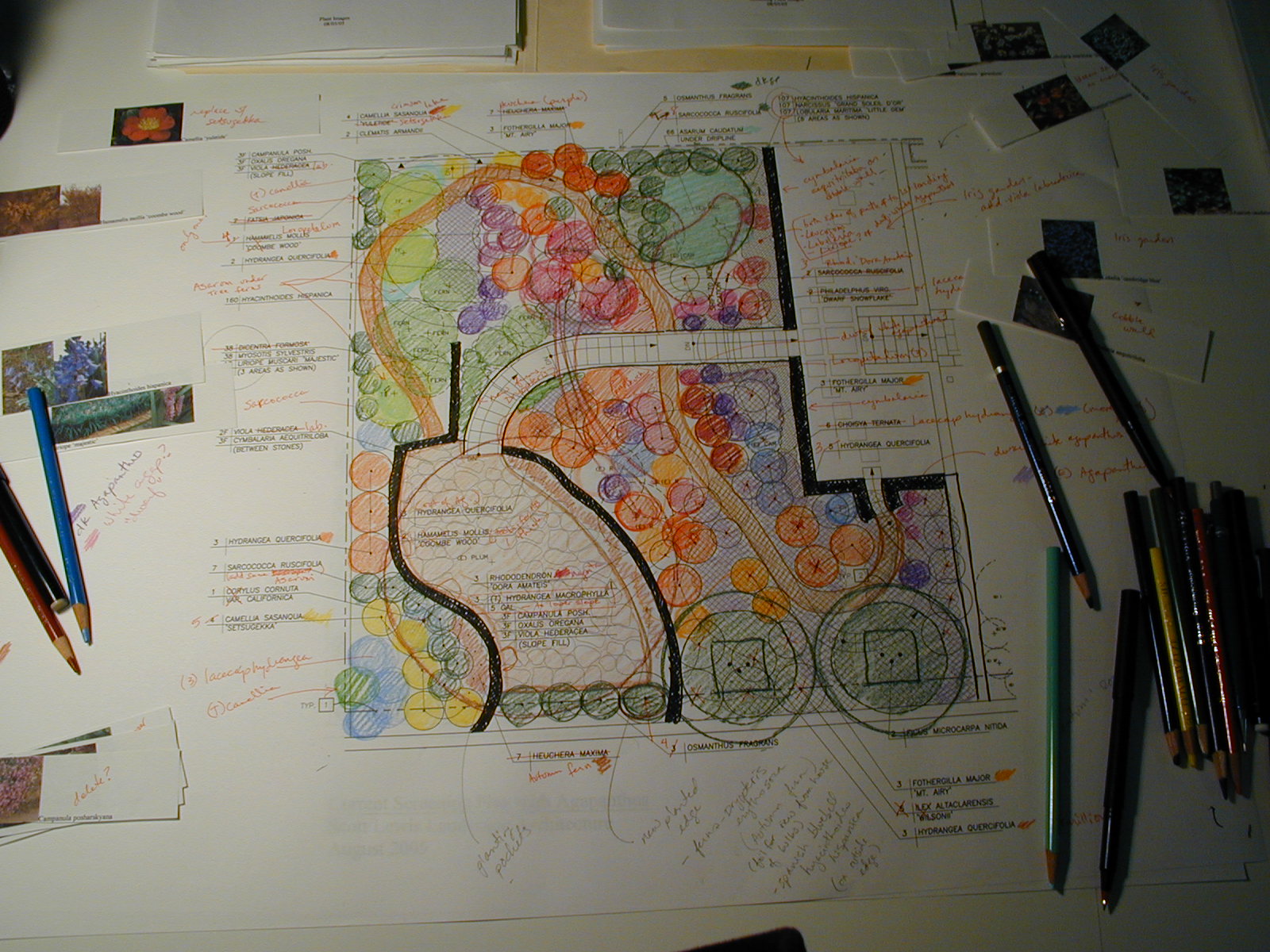 Thanks!
Thanks!









